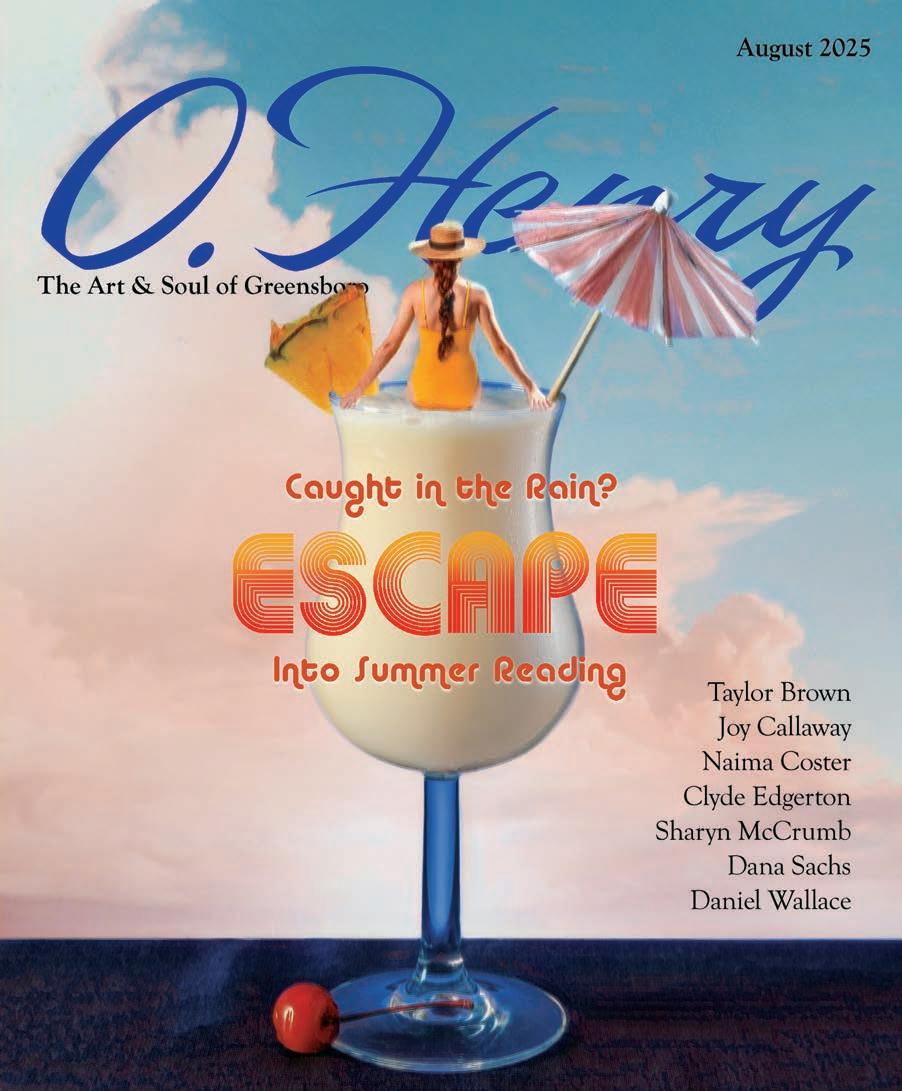
















Art galleries • Bars + Tap room • Shops • Services
Events • History exhibits • and so much more













Dr. Edward Gronet, Board-Certified Plastic Surgeon, has been selected as a Castle Connolly Top Doctor, a prestig ious distinction awarded to only the top 7% of physicians in the Uni ted States. This honor recognizes Dr. Gronet's exceptional clinical expertise, as well as his outstanding interpersonal skills, ensur ing patients receive the highest standard of care and personaliz ed attention.
At H/K/B MedSpa, we offer the latest advanced treat ments designed to rejuvenate and enhance your natural bea uty. Now is the perfect time to refresh and revitalize your ski n. Whether you're looking to restore youthful radiance or smooth and tighten your skin, our expert team is here to help you feel your best with a refreshed glow.


49 What We Talk About When We Talk
About the Moon Poem by Elizabeth W. Jackson
50 Paper Tales Summer reading issue
64 Drawing Room By Maria Johnson Greensboro cartoonist Tim Rickard reflects on two decades of Brewster Rockit
68 Murals, Music, Museums By Danielle Rotella Adams Exploring Elkin, one of North Carolina’s underrated destinations
72 The Gentlewoman and Happy Farmer By Cynthia Adams Margie Benbow bought the farm
81 August Almanac By Ashley Walshe
13 Chaos Theory By Cassie Bustamante 17 Simple Life By Jim Dodson 20 Sazerac 27 Tea Leaf Astrologer By Ashley Walshe
Life’s Funny By Maria Johnson 32 The Omnivorous Reader By Anne Blythe
Home Grown By Cynthia Adams 39 Birdwatch By Susan Campbell 41 Wandering Billy By Billy Ingram 92 Events Calendar
101 GreenScene
104 O.Henry Ending By Cassie Bustamante
Cover: John Gessner, Devon Gessner, K eith BorshaK
PhotoGraPh this PaGe By John Gessner





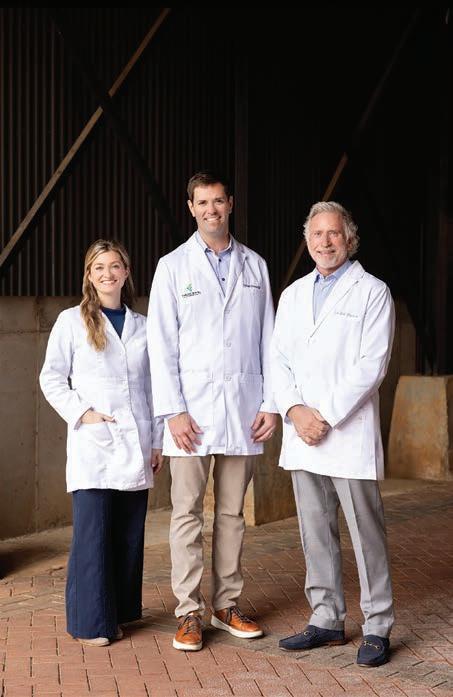


MAGAZINE
volume 15, no. 8
“I have a fancy that every city has a voice.” www.ohenrymag.com
PUBLISHER David Woronoff david@thepilot.com
Andie Rose, Creative Director andiesouthernpines@gmail.com
Cassie Bustamante, Editor cassie@ohenrymag.com
Jim Dodson, Editor at Large jwdauthor@gmail.com
Keith Borshak, Senior Designer
Campbell Pringle, Design Intern
CONTRIBUTING EDITORS
Cynthia Adams, David Claude Bailey, Maria Johnson
CONTRIBUTING PHOTOGRAPHERS
Betsy Blake, Lynn Donovan, Amy Freeman, John Gessner, Bert VanderVeen, Mark Wagoner
CONTRIBUTORS
Danielle Rotella Adams, Harry Blair, Anne Blythe, Susan Campbell, Jasmine Comer, Ross Howell Jr., Billy Ingram, Tom Maxwell, Gerry O’Neill, Liza Roberts, Stephen E. Smith, Zora Stellanova, Ashley Walshe, Amberly Glitz Weber
ADVERTISING SALES
Lisa Allen
336.210.6921 • lisa@ohenrymag.com
Amy Grove
336.456.0827 • amy@ohenrymag.com
Brad Beard, Graphic Designer
Jennifer Bunting, Advertising Coordinator ohenrymag@ohenrymag.com
Henry Hogan, Finance Director 910.693.2497
Darlene Stark, Subscriptions & Circulation Director 910.693.2488
OWNERS
Jack Andrews, Frank Daniels III, David Woronoff In memoriam Frank Daniels Jr.


CHOOSE YOUR PATH.
Discover the breathtaking, 360-degree views from the Monadnock Lookout Tower at Cane Creek Mountain Natural Area. Climb 80 feet to stand just above the tree line to experience a bird’s-eye view of the natural beauty of rolling hills and lush forests. Across our area, you’ll find trails winding their way through parks, alongside lakes and over enchanted waterways – such as the Haw River Trail, part of the Mountains to Sea Trail.
What you find at the end of the trail may just be yourself.
You’ll find small surprises lead to big memories in Alamance County.

























By Cassie Bustamante

Whenmy daughter, Emmy, met her first-year Penn State roommate, Taylor, online this summer, the young women exchanged full names for their roommate request forms.
“Emerson is your full name?” Taylor texted. “It’s really pretty! My mom thought so, too.”
“Yeah,” Emmy replied. “My mom gave us all literary names. I’m named after Ralph Waldo Emerson. My older brother, Sawyer, is named after Tom Sawyer, and my little brother, Wilder, after Laura Ingalls Wilder.”
“That is actually so badass,” messaged Taylor. “I aspire to name my kids after literary legends like your mom.”
As for my own first name, it did not come from literature. Nor did it come from Greek mythology. You know the story — the ill-fated Cassandra, able to see the future with utter clarity but cursed by Apollo to be believed by no one. So many times, I had to explain that wasn’t even close to what my mother had in mind. She’d been just 13 when she heard it on the original vampire soap opera, Dark Shadows, swearing that if she one day had a daughter, she would name her Cassandra, just like the show’s witch. Nine years later, I was born.
“But she was just so beautiful,” my mom said, telling me, in her defense, about how my name had a dark side. Never mind that she was not a good witch by any stretch of the imagination. As a teenager myself, I’d landed on the name Hadley if I ever had a girl. Ah, Hemingway’s wife, right? Alas, that’s not my source. You see, I grew up in a small town in Western Massachusetts. We weren’t far from charming places you may have heard of, like
Northampton and Amherst. Nestled between them is the quaint village of Hadley and below that, naturally, is South Hadley, home to my favorite woodsy escape during my high school years: Skinner Mountain. I took countless hikes there with my dad or with friends, sometimes both.
Nearby was a café called the Thirsty Mind, still there today. After a fall hike, we’d reward ourselves with giant chocolate chip cookies and steaming cups of hot cocoa. Or my pals and I would venture there at night, sipping tea and playing Chinese checkers or one of the many other well-loved games the shop had lying around. All that to say, South Hadley holds a special place in my New England-loving heart.
So, when my husband, Chris, and I found ourselves preparing for our first child in 2005, I was sure I was carrying little miss Hadley. That is, until the doctor pointed out that I may want to consider Hudson versus Hadley because there on the ultrasound were very clear boy parts. I spent the next couple of months agonizing over names. As an Enneagram type four (the personalitytype system’s “individualist”), I wanted a name I’d never heard on another person before. The English major in me thought perhaps literature could inspire me and I recalled the collections of novels my brother and I had on our shelves as children. One stood out: The Adventures of Tom Sawyer.
“ Sawyer,” I said aloud to Chris.
It was a good, strong name, he agreed. What he didn’t dare tell me was that there was a character named Sawyer on his current favorite television show, Lost, which began airing just a few months before I found out I was pregnant. By the time someone mentioned it to me, I was already calling the growing baby in my belly Sawyer. It was a done deal.
When Sawyer was 9 months old, we found out his little sister



March


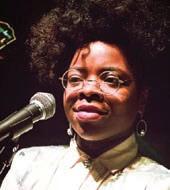
Come Sunday Jazz 2025-2026
Season Tickets are now available!
Save 20% by subscribing to our Come Sunday Jazz Series! This ticket will grant you access to all 6 of our Jazz events.
This month at Weymouth Center:
August 1: Weymouth Lecture Series: Dante Poole
August 19: James Boyd Book Club
August 20: Book Launch: Because I Did Not Drown with author Pat Riviere-Seel
August 26: Song Circle
August 31: Come Sunday Jazz: Sidecar Social Club


was on the way. And while I still loved the name Hadley, its time had passed.
“What about Emilia?” I asked Chris. “Emilia Bustamante. Doesn’t that sound pretty? And we could call her Emmy.”
“Sounds too Spanish,” he replied dryly.
“Um, you are Cuban,” I said.
“I do like Emmy, though,” he said.
With that in mind, I continued to ponder names. What else could I shorten to Emmy?
Emma? Too common.
Emmet? All I could picture was a washtub-bass-playing Muppet otter.
Emerson, as in Ralph Waldo Emerson, poet, writer, philosopher? Sign this literary-lover up!
Years later, when the last of our gaggle of children was due to arrive, I decided he had to follow the precedent we set with his siblings — a name inspired by a writer or literary character. I was not a Thornton Wilder fan, so apologies to those who think the baby of our family, Wilder, was named for him. But Laura Ingalls Wilder? Yes, indeed. I’ll take Little House over Our Town any day. So infatuated was I as a child that my mother sewed me a floral dress, apron and bonnet so that I could not only appreciate Laura, but I could channel her, too.
And now Wilder will have to go through life probably explaining to people, “No, no. My mom’s a big book nerd, but it’s not that playwright Thornton dude or even the kid from the novel White Noise. Nope — I’m named after some little girl who lived in some little house on some great big prairie.”
Scan the QR code for tickets and additional information!
555 East Connecticut Avenue, Southern Pines, NC
“But she was a brilliant writer,” I’ll tell him! And I’ll remind him of the quote of hers I had over his crib when he was a baby: “Some old-fashioned things like fresh air and sunshine are hard to beat. In our mad rush for progress and modern improvements let’s be sure we take along with us all the old-fashioned things worth while.” Like a good name. OH
Cassie Bustamante is editor of O.Henry magazine. She cannot see the future nor cast spells that work — yet.
















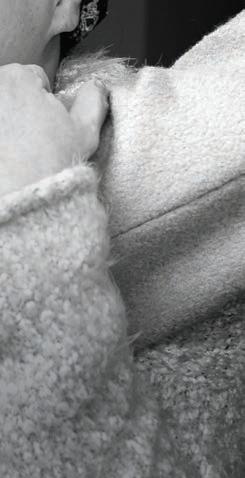


Catch it before it fades
By Jim DoDson
Most mornings before I begin writing (often in the dark before sunrise), I light a candle that sits on my desk.
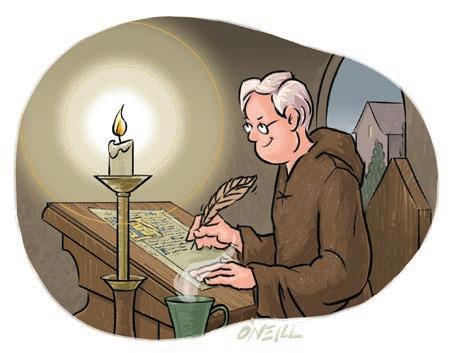

Somehow, this small daily act of creating a wee flame gives me a sense of setting the day in motion and being “away” from the madding world before it wakes. I sometimes feel like a monk scribbling in a cave.
It could also be a divine hangover from early years spent serving as an acolyte at church, where I relished lighting the tapers amid the mingling scents of candle wax, furniture polish and old hymnals, a smell that I associated with people of faith in a world that forever hovered above the abyss.
According to one credible source, the word “light” is used more than 500 times in the Bible, throughout both Old and New Testaments. On day one of creation, according to Genesis, God “let there be light” and followed up His artistry on day four by introducing darkness, giving light even greater meaning. The Book of Isaiah talks about a savior being a “light unto the gentiles to bring salvation to the ends of the world.” Throughout the New Testament, Jesus is called the “Light of the world.”
But spiritual light is not exclusive to Christianity. In the Torah, light is the first thing God creates, meant to symbolize knowledge, enlightenment and God’s presence in the world. Surah 24 of the Quran, meanwhile, a lyrical stanza known as the “Verse of Light,” declares that God is the light of the heavens and the Earth, revealed like a glass lamp shining in the darkness, “illuminating the moon and stars.”
Religious symbolism aside, light is something most of us probably take for granted until we are stopped in our tracks, captivated by the stunning light show of a magnificent sunrise or sunset, a brief and ephemeral painting that vanishes before our eyes.
Sunlight makes sight possible, produces an endless supply of solar energy and can even kill a range of bacteria, including those that cause tetanus, anthrax and tuberculosis. A study from 2018 indicated rooms where sunlight enters throughout the day are significantly freer of germs than rooms kept in darkness.
The intense midday light of summer, on the other hand, is something I’ve never quite come to terms with. Many decades ago, during my first trip to Europe, I was fascinated (and quite
pleased, to be honest) to discover that, in most Mediterranean countries, the blazing noonday sun brings life to a near standstill. Shops close and folks retreat to cooler quarters in order to rest, nap or pause for a midday meal of cheese and chilled fruit. I remember stepping into a zinc bar in Seville around noon and finding half the city’s cab drivers hunkered along the bar. The other half, I was informed, were catching z’s in their cabs in shaded alleyways. The city was at a complete, sun-mused halt.
The Spanish ritual of afternoon siesta seems entirely sensible to me (a confirmed post-lunch nap-taker) and is proof of Noel Coward’s timely admonition that “only mad dogs and Englishmen go out in the midday sun.” Spend a late summer week along the Costa del Sol and you can’t avoid running into partying Brits on holiday, most as red as boiled lobsters from too much sun.
In his raw and gothic 1932 novel, Light in August, a study of lost souls and violent individuals in a Depression-era Southern town, William Faulkner employs the imagery of light to illuminate marginalized people struggling to find both meaning and acceptance in the rigid fundamentalism of the Jim Crow South.
For years, critics have debated the title of the book, with most assuming it is a direct reference to a house fire at the story’s center.
The author begged to differ, however, finally clearing up the mystery: “In August in Mississippi,” he wrote, “there’s a few days somewhere about the middle of the month when suddenly there’s a foretaste of fall, it’s cool, there’s a lambence, a soft, a luminous quality to the light, as though it came not from just today but from back in the old classic times. It might have fauns and satyrs and the gods and — from Greece, from Olympus in it somewhere. It lasts just for a day or two, then it’s gone . . . the title reminded me of that time, of a luminosity older than our Christian civilization.”
I read Light in August in college and, frankly, didn’t much care for it, probably because, when it comes to Southern “lit” (a word that means illumination of a different sort), I’m far more attuned to the works of Reynolds Price and Walker Percy than those of the Sage of Yoknapatawpha County. By contrast, a wonderful
book of recent vintage, Anthony Doerr’s All the Light We Cannot See, tells the moving story of a blind, French girl and young, German soldier whose starstruck paths cross in the brutality of World War II’s final days, a poignant tale shot through with images of metaphorical light in a world consumed by darkness.
But I think I understand what Faulkner was getting at. Somewhere about middle-way through August, as the long, hot hours of summer begin to slowly wane, sunlight takes a gentler slant on the landscape and thins out a bit, presaging summer’s end.
I witnessed this phenomenon powerfully during the two decades we lived on a forested coastal hill in Maine, where summers are generally brief and cool affairs, but also prone to punishing mid-season droughts. Many was the July day that I stood watering my parched garden, shaking my cosmic gardener’s fist at the stingy gods of the heavens, having given up simple prayers for rain.
On the plus side, almost overnight come mid-August, the temperatures turned noticeably cooler, often preceding a rainstorm that broke the drought.
When summer invariably turns off the spigot here in our neck of the Carolina woods, sometime around late June or early July, I still perform a mental tribal rain dance, hoping to conjure afternoon thunderstorms that boil up out of nowhere and dump enough rain to leave the ground briefly refreshed.
I’ve been fascinated by summer thunderstorms since I was a kid living in several small towns during my dad’s newspaper od-
yssey through the deep South. Under a dome of intense summer heat and sunlight, where “men’s collars wilted before nine in the morning” and “ladies bathed before noon,” to borrow Harper Lee’s famous description of mythical Maycomb, I learned to keep a sharp eye and ear out for darkening skies and the rumble of distant thunder.
I still gravitate to the porch whenever a thunderstorm looms, marveling at the power of nature to remind us of man’s puny place on this great, big, blue planet.
Such storms often leave glorious rainbows in their wake, supposedly a sign (as I long-ago learned in summer Bible School) of God’s promise to never again destroy the world with floods.
Science, meanwhile, explains that rainbows are produced when sunlight strikes raindrops at a precise angle, refracting a spectrum of primary colors.
Whichever reasoning you prefer, rainbows are pretty darn magical.
As the thinning light of August and the candle flame on my desk serve to remind me, the passing days of summer and its rainbows are ephemeral gifts that should awaken us to beauty and gratitude before they disappear. OH
Jim Dodson is the founding editor of O.Henry. His 17th book, The Road That Made America: A Modern Pilgrim Travels the Great Wagon Road, is available wherever books are sold. Wed - Fri / 9:30a - 5:00p Sat / 9:30a - 4:30p


















"A spirited forum of Gate City food, drink, history, art, events, rumors and eccentrics worthy of our famous namesake"
August, it turns out, is the month that most babies are born in the United States. Editor Cassie Bustamante and her older brother are both earlymonth Leos, born a couple years apart. Knowing that, we don’t have to guess what many Americans are up to in early November, when the weather cools and the days darken. Brown chicken brown cow, if ya catch us. We thought we’d share a list of words we’re fond of that sound like they’d make beautiful baby names, but which we beg you not to use for your August child.
Calamity. Sure, it means sudden disaster, but it rolls adorably off the tongue. And wouldn’t Callie be a sweet nickname?
Dash. Em dash, en dash, DoorDash. Frankly, we like all the dashes. It could even be short for Kardashian, but, whatever you do, never — ever — call them Hyphen.
Lattice. Like Gladys — and makes us think of flowering vines. Or atoms arranged in a crystalline solid, whichever floats your boat.
Typhus. Dionysus was the Greek god of wine, vegetation and fertility. His brother, Typhus, may have been the god of lice, chiggers and fleas.
Arugula. She’s feminine but a little peppery, too. And we bet anyone with this name won’t fight you on eating her greens. Imbroglio. Sounds masculine and Italian and we’re here for it. Google the meaning before you use it, though, or you might find yourself in “an acutely painful or embarrassing misunderstanding.”
What’s in a name? Well, everybody who’s had a halfway decent English teacher knows that dandelion is derived from the Anglo-French phrase “dent de lion” (lion’s teeth, from the leaf’s indented teeth). But did you know that tulip comes from the Turkish “tülbent,” meaning turban; or that the petunia’s name is from the Tupi word petíma for tobacco, stemming from how the two plants are botanically related; or that azalea is Greek for dry, parched and withered, so named for its ability to thrive in a dry climate?
Probably not, unless you subscribe to Merriam-Webster’s Word of the Day.
It’s my guess that the author of that piece probably has a copy of Diana Wells’ 100 Flowers and How They Got Their Names, along with William T. Stearns’ Dictionary of Plant Names for Gardeners. And I suspect his or her copy is as tattered as mine is. So let’s start with the dogwood, our state flower, whose wood was supposedly used to build the Trojan horse and whose berries turned Odysseus’ men into pigs. That, according to Wells, who also says the tree’s leaves, bark and berries “have been used to intoxicate fish, make gunpowder, soap and dye, make ink and clean teeth.” You’ve doubtless heard the legend that the old, rugged cross was made of dogwood, and Jesus, feeling the tree’s remorse, transformed it henceforth into a twisted dwarf so that it could never be used for another crucifixion. As for its name, I’m understandably partial to the 1922 theory of L.H. Bailey that its leaves were used to shampoo mangy dogs.

The pine, our state tree, springs from the Latin “pinus,” which etymologists guess (they do a lot of that) derives from a form of the verb “pie,” which means “to be fat or to swell,” with their opining it’s a reference to the pine’s sap or pitch.
Let’s just skip over orchid, which comes from the Greek “orchis,” meaning testicle. And who wants to dwell on the origin of forsythia, named after English gardener William Forsyth, whose recipe for Forsyth’s fruit-tree-healing plaster consisted of cow dung, lime and wood ashes amplified by a splash of soapsuds and urine?
Let’s just go back to Merriam-Webster’s Word of the Day, which once featured plant names that sound like insults. Go ahead, call someone a hoary vervain, stink bell, bladderwort or a dodder. I could go on and on, but my editor has a thing about brevity. So I’ll close with my favorite names of wildflowers — whorled tickseed (whorled means a pattern of spirals or concentric circles), Jacob’s ladder, sweet William, Dutchman’s breeches, foam flower, American boneset, Joe Pie weed, white turtlehead and lanceleaf blanket flower. Pure poetry on the stem or vine. What is it about our wanting to know the names of plants and animals, as if that little tidbit of knowledge gives us some kind of power? And what is it about a plant’s name that seems so intriguing? As my guide once blurted out after two weeks on a tributary in the furthest reaches of the Amazon River, “Bailey, most people just want to know the name of the dingus, and once told, they shut up. But you’re relentless and keep asking questions.” I told him that it was in my job description as a reporter and an incredibly nosy parker. Besides, I said, I was an English major — until I changed my major to Classical Greek. He just shook his head.
— David Claude Bailey


As children, we’re taught to recognize patterns. Our music teacher has us clap out one-two, one-two-three. Our science teacher shows us how to recognize patterns in nature’s wonder — the gills of a mushroom or the arrangement within a DNA molecule. Often, as adults inundated with information, we forget to take a moment to appreciate how patterns stimulate our brains. Weatherspoon’s current exhibit, “Pattern Recognition,” reminds us to find the beauty and meaning in them. Linda Besemer’s Baroquesy, 1999 — featuring acrylic paint over aluminum rod, is part of the Weatherspoon collection on display in this exhibit. California-based Besemer knows a thing or two about pattern recognition and society’s strictures about the use of color. “What’s so predictable about the ‘too colorful’ rejection is that it implies that some color is OK, but too much is unacceptable,” she told Scottish artist and writer David Batchelor just a few years after this piece’s creation. She went on to say that she thinks “that the real problem with color is its containment and regulation.” Which, she says, reminds her of how artists have regarded the female body throughout the history of Western art. Submerge your mind into Weatherspoon’s world of pattern — and so much more — through Jan. 10, 2026. Info: weatherspoonart.org/exhibitions_list/pattern-recognition.
Back in the 1950s when families still swam in Lake Hamilton, most moms chatted on the shore as they kept a watchful eye on their children. But not Betty. She just wanted to be left alone with her magazine. And who can blame her?










Leaving Lowe’s on Battleground one weekday, I felt a massive pang of nostalgia. The center of that entire property, directly across from ALDI, was the location of the studio and tower for WBIG 1470 AM radio, where Bob Poole broadcast his enormously popular morning show, Poole’s Paradise, throughout the ’50s, ’60s and ’70s.

The quick-witted, basso-buffo voiced, selfanointed “Duke of Stoneville” relocated to Greensboro from his New York network perch in 1952. Soon after, Bob and my father became drinking buddies. As a toddler visiting WBIG’s “Poole Room” while he was broadcasting live, I joined in whistling his theme song, which made Bob burst out laughing. As a teenager, some mornings I’d drop by the station with joke and trivia books.
After faithfully awakening Gate City denizens for 25 years with an audience share that will never be equalled, Bob Poole signed off mere weeks before his death in 1977. Legendary WCOG DJ Dusty Dunn inherited the “BIG” morning slot. In an interview conducted years ago, Dunn recalled negotiating his contract and, of all things, being asked if he wanted batteries included in his employment package: “I said, ‘Batteries? Batteries
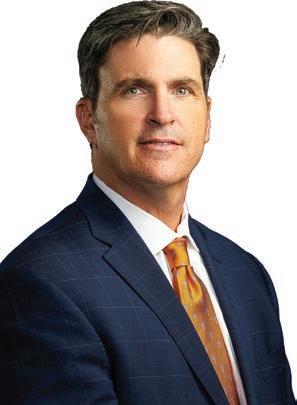
for what?’ She said, ‘Well, we gave Bob Poole batteries for his flashlight when he wakes up in the morning so he didn’t have to turn on the lights and wake his wife up.’ I couldn’t believe it!”
On the afternoon of November 20, 1986, after celebrating 60 years on the air, the parent company informed WBIG’s general manager that the station would go dark at 6 that evening. Shocked staffers and longtime on-air personalities gathered for a tearful sign-off led by Dusty Dunn.
That decision was basic economics — a relatively small operation was nestled atop an entire city block along Battleground Avenue’s exploding retail corridor, a plot of dirt far more valuable than any revenue a weak AM radio signal could generate.
The last shred left of WBIG’s existence on Battleground is Edney Ridge Road, separating ALDI and Lowe’s, in the 1950s paved for and christened after the founder of the station whose call letters were an initialism for We Believe In Greensboro.
— Billy Ingram




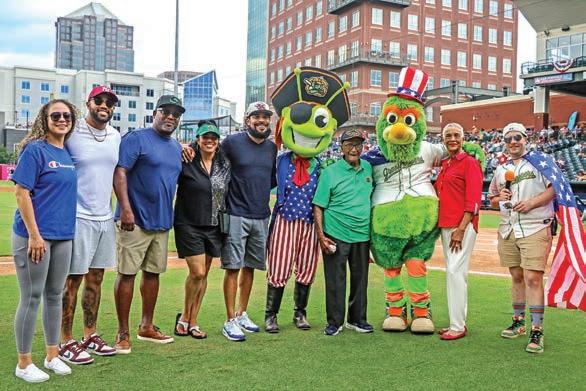



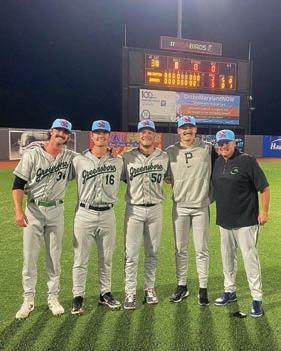







1725 NC 66 South, Kernersville, NC 27284 336-564-1010 / www.bmhs.us
Founded in 1959, Bishop McGuinness Catholic High School is proud to be the largest non-public high school in North Carolina’s Piedmont Triad. Located just minutes from Greensboro, WinstonSalem, and High Point, our 42-acre campus offers a safe, nurturing environment where students can thrive academically, socially, and spiritually. Through exceptional academics, extracurricular activities, athletics, and a deep commitment to spiritual growth grounded in the Gospel, we provide an outstanding high school experience
A I T H & S E R V I C E
1 Full-t ime Chaplain
1 Full-t ime Campus Minist r yCoordinator
13,000+ Communit y S er v ice hours completed each year


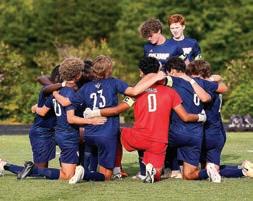


100% Graduat ion Rate and over $10M in College S cholarships awarded each year
2


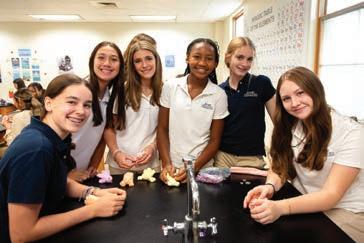
( July 23-August 22)
Outfit, moisturizer or relationship: If it doesn’t shimmer, glitter or downright sparkle, let it go. And while you’re at it, release the urge to draft another birthday reminder text. Don’t you deserve to be celebrated? Of course! But here’s the thing: Nobody can shower you with royalty-level opulence better than you can. When Venus enters your sign on Aug. 25, put on your flashiest threads, crank up some Bruno Mars and treat yourself to some over-the-top ME time.
Tea leaf “fortunes”
Virgo (August 23 – September 22)
A certain houseplant requires your attention.
Libra (September 23 – October 22)
Explore a new color palette.
Scorpio (October 23 – November 21)
You’re going to want some reinforcement.
Sagittarius (November 22 – December 21)
Something smells like trouble.
Capricorn (December 22 – January 19)
Trust your instincts.
Aquarius (January 20 – February 18)
Drink more water.
Pisces (February 19 – March 20)
Best to cut the rope.
Aries (March 21 – April 19)
It’s time to delete the app.
Taurus (April 20 – May 20)
You gotta know when to fold ’em.
Gemini (May 21 – June 20)
Butter the popcorn, sweetheart.
Cancer (June 21 – July 22)
Dare you to go all out. OH
Zora Stellanova has been divining with tea leaves since Game of Thrones’ Starbucks cup mishap of 2019. While she’s not exactly a medium, she’s far from average. She lives in the N.C. foothills with her Sphynx cat, Lyla.

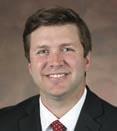
If you are a woman age 40 or older and have not had your screening mammogram this year, now is the time!
At Outpatient Imaging, we make it easy!
• No doctor’s order needed
• Open six days a week with expanded hours
• Close to home at 3120 Northline Ave @ Friendly Shopping center




Terms and Conditions: $300 off any order of $1198 or more,$200 off any order of $998-$1198 or $100 off any order of $698-$998, on any complete custom closet, garage,or home office unit. Not valid with any other offer. Freeinstallation with any complete unit order of $600 or more. With incoming order, at time of purchase only. SPECIAL FINANCING For 12 months! Expires in 90 days. Offer not valid in all regions.





By m aria Johnson
Consider the day I go shopping for personal care items, and I’m stopped cold by a stack of imposing black packages on a shelf crammed with otherwise brightly colored products.


I move closer to the interloper.
“Dude Wipes,” the soft-sided package proclaims. “48 flushable wipes. Mint Chill, with mint and eucalyptus oils.”
Wet wipes? Specifically for men?
I scan the package for more clues. My eyes fall on a big one: “XL.”
No other size is available.
Yep. This is definitely a product by men, for men. Since when would a man cop to needing anything other than an extra large?
I flip over the package, hoping for some kind of explanation. Sure enough, there is the origin story:
“Back in the day, we founded DUDE out of our apartment in Chicago. We were so tired of dealing with dry toilet paper during the aftermath of a lunchtime burrito. Something needed to be done. So we created DUDE Wipes to put you back on your game whenever nature calls.”
It is signed “DUDE.”
Simply “DUDE.”
Next to the backstory are directions: “Grab one and wipe, Dude.”
Well, I think to myself, this is a good thing. At least some men will understand the concept of mansplaining now.
Right next to the directions lie an American flag and an assurance — for those worried about foreign-born wipes — that the disposable cloths are “Assembled in the U.S.”
At times like this, I have so many questions. Truly, it’s the downside of curiosity, especially when I’m in a hurry.
But it doesn’t stop me from wondering: Are baby wipes not enough for the XYs among us? Are the tyke towelettes too small? Too flimsy? Too childish?
And burritos? Really? Is that a legit story or just marketers blowing mesquite smoke?
And what’s up with mint chill? Is that a flavor? Or a sensation?
I look up to see a man and a woman pushing a cart toward me. The narrow aisle requires me to move my cart over. They’re eyeing the package I am holding.
“Have you seen these?” I say, holding up the wipes and offering a faint laugh. “They’re for men.”
They hurry by me. I feel vaguely embarrassed. Will they wheel their cart straight to the manager and report a woman fondling the Dude Wipes?
I tuck the package back onto the shelf and round the corner. I almost run into Duke Cannon.
Do you know Duke?
Duke Cannon Supply Co.?
You might recognize the blocky “D” on their displays.
They make a relatively new line of grooming products including a hand balm called “Bloody Knuckles,” featuring a label with two old-timey boxers wearing handlebar mustaches and long pants; a lip balm that claims to be “Offensively Large” (what else?); and face and body wipes that fly under the banner of “Cold Shower,” a product clearly meant to chill the overheated front-sides of fellows.
By now, I am indelibly aware that Dude Wipes has their backsides covered.
There’s more.
Duke Cannon also make soaps, apparently for Dude users when they decide it’s time for a deep cleaning.
One product, the “Big Ass Brick of Soap,” is available in the dangerously romantic scent of Midnight Swim; the militarily dominant fragrance of Midway (as in the World War II Battle of Midway?); and the aromatic Buffalo Trace edition, which swears it’s made with real Kentucky straight bourbon whiskey.
Because alcohol cuts grease?
Because everyone wants their employer to catch a whiff of booze on them first thing in the morning?
Should a Duke user not want to risk dropping his soap in the shower, the company also sells a “tactical scrubber,” aka a mesh pouch with a carrying strap.
More effeminate consumers might call this soap on a rope, a fact acknowledged in Duke’s fine print because, seriously, who knows what a tactical scrubber is anyway? Something that goes on a smoke stack in a war zone? Someone who scrubs military









intel from classified files?
I think of a potential baby shower gift I saw recently: a “tactical baby carrier” for dad. The product listing showed the midsection of a burly, tattoo-sleeved man. Infant limbs protruded from a heavy-duty sling, which was available in black, camel, olive and camouflage.
The grammarian in me was puzzled. Which word, I wondered, was “tactical” intended to modify?
Was the baby tactical? A little Army Ranger?
Or was the carrier tactical? And if so, in which way? Tactical in the sense that mom finally figured out a way for dad to help carry the load, literally?
As I said, curiosity can stand in the way of efficient shopping. So can nostalgia.
Standing there in front of the Duke display, I’m wistful for the nonbinary days of Jergens and Ivory soap. I turn down the antiperspirant aisle hoping for a whiff of neutrality.
menacing manga-style cartoon characters with names such as RaptorStrike, Wolfthorn, NightPanther and BearGlove.
Here, women only glow in pastel products that make them smell of rose, nectarine, lavender, vanilla and water lily. Never mind that no one this side of White Lotus season three knows what a water lily smells like; it sounds lovely. And hydrating.
Here, adult men are secure in their black, gray and occasionally fire-engine-red containers filled with products scented to evoke Timber, Deep Sea, Orchard and, because it’s 5 o’clock somewhere, Apple Cider Bourbon, Whiskey Smash and Mint Mojito.
Presumably, one application causes drunkenness, woodchopping or perhaps winning a marlin fishing tournament.
I briefly consider buying several sticks of the the timberscented deodorant, smearing my entire body with it, and seeing if that inspires me to hack down the invasive Russian olive shrubs in our backyard.
But I have more pressing plans, underarms and underbrush be damned, so I stoop down to the bottom shelf and grab a stick of boring (and less expensive) Arm & Hammer deodorant. It feels like an act of rosemary-and-lavender-scented defiance.
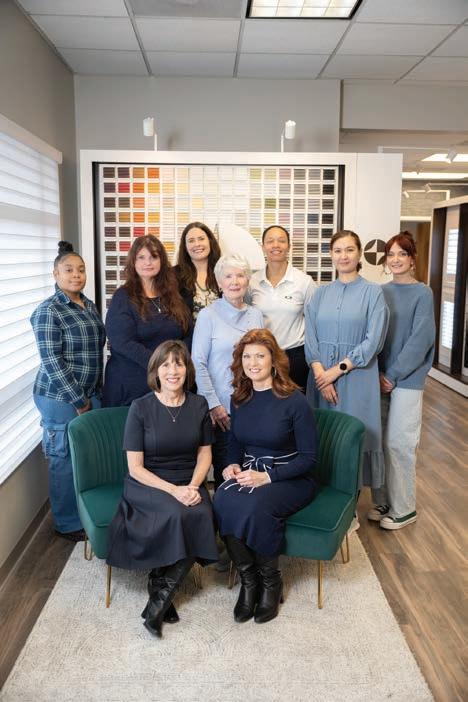
Maria Johnson is a contributing editor of O.Henry magazine. Email her at ohenrymaria@gmail.com.


Window Works Studio, we do more than just dress windows—we transform spaces. As a Hunter Douglas Gallery Dealer, we offer exclusive collections, expert design consultations, and white-glove service from start to flawless finish.



By A nne Blythe
Thesedays, as social media platforms and conflicting political rhetoric abound, it can be difficult to discern fact from fiction. It’s tempting to reflect on the past to try to understand what might be prologue.
Sometimes, though, the history that has been fed to us over time turns out to be pure fiction — or at least some version of it. Other times fiction is better able to get to the nitty-gritty truth. Historical fiction with its modern lens on days gone by can release the anchors of time and enhance a reader’s experience and understanding of the past in ways that non-fiction does not always accomplish.
Three North Carolina writers from this genre, to name a few, have taken a stab at blurring the lines between the invented and the real with new historical fiction that spans many decades, and in one case centuries.
Charlotte-based author Joy Callaway transports readers of her seventh book, The Star of Camp Greene: A Novel of WWI, far beyond the Queen City’s modern financial district and tree-lined neighborhoods back to 1918, when the U.S. Army had a training facility about a mile west of what is now Uptown.
Nell Joslin, a Raleigh lawyer turned writer, takes readers of her debut novel, Measure of Devotion, back to the Civil War era as she chronicles a mother’s harrowing journey from South Carolina, where she was a Union supporter, to the battleground regions of southeastern Tennessee to tend to her critically wounded son, who enlisted with Confederate troops in defiance of his parents’ wishes.
And Reidsville-based Valerie Nieman, a former newspaper reporter and editor turned prolific author, takes readers on a journey to ancient Scotland in Upon the Corner of the Moon in her imagined version of Macbeth’s childhood before he became King of Alba in 1040.
shift Liberty Theatre tent at the North Carolina training camp. The soldiers gathered were all smiles until a pall was cast over her act by the news of deaths in the Flanders battlefields near Brussels.
Despite the push of men moving to the back of the tent to absorb the unwelcome announcement, Calla thought it was important to continue the entertainment, providing a crucial diversion during somber times. But her head hurt. Sweat soaked through her costume as heat flushed through her body before an icy cold set in. The Spanish flu was circulating around the world, claiming more lives than the overseas conflict for which Camp Greene was training soldiers.

Calla was bent on impressing the men enough that word would spread to Gen. John J. Pershing. In her mind, he would make the final decision whether or not she could join the team of performers who traveled overseas to entertain the troops — and thus honor the memory of the fiancé she had lost to the war there. But she couldn’t stop the spinning as she tried desperately to belt out lines from George M. Cohan’s “Over There.”
Stricken with the deadly influenza, Calla ends up in the hospital. While recuperating, she overhears a piece of classified military intelligence resulting in her confinement at the Charlotte camp, where she’s assigned a chaperone until further notice. While prevented from traveling to the front, it opens her to the possibility of new love and gives Callaway an opportunity to explore themes of patriotism and injustice.
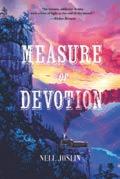
Though the books are very different, each was born from digging through historical documents, archives and histories of the time, as well as a bit of on-the-ground research.
Callaway’s main character, Calla Connelly, is based on the real-life vaudeville star Elsie Janis, a so-called “doughgirl” who sang, spun stories and cartwheeled across the stage for American troops on the Western Front. The Star of Camp Greene opens with Calla toughing her way through a performance in the make-
Measure of Devotion also tells the story of a war era through a strong, compelling female character. Through vivid and immersive writing, Joslin uses the 36-year-old Susannah Shelburne to bring life to the story of mothers nursing wounded sons near Civil War battlefields.
Susannah, who grew up in Madison County, North Carolina, and her husband, Jacob, live in South Carolina, where they are opposed to slavery in the very land that is fighting to preserve it. Jacob’s family had owned slaves, but the thought of another person being nothing more than property appalled him. After inheriting Hawk, Jacob granted him his freedom and paid him to work for him. They also employed Letty, a character whose homespun wisdom, optimism and love adds a welcome layer to a tender and complicated story.
The Shelburnes’ son, Francis, joined the 6th South Carolina Volunteers in the early years of the war, and on Oct. 29, 1863, his parents receive a telegram letting them know that their son had
been severely wounded by shrapnel near his hip joint. Susannah leaves her ailing husband and travels by rail to Lookout Mountain, Tennessee, with hopes of sparing Francis’ leg from amputation while nursing the 21-year-old back to health. He’s in a fevered state when she arrives.
Joslin adroitly and compassionately explores heady themes that divided the country more than 150 years ago, and the hardships and ravages of a nation at war with itself.
Nieman’s Upon the Corner of the Moon is book one of two that explore some of those same issues in 11th-century medieval Scotland. Rather than relying on William Shakespeare’s depiction of Macbeth, Nieman alternates her deeply researched tale of the budding powers of the Macbethian royal court through three voices — Macbeth, Gruach, who becomes his queen, and Lapwing, a fictional poet.
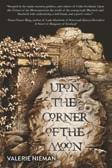
Separately, Macbeth and Gruach are spirited away from their parents to be fostered into adulthood during an era of constant warfare and the unending struggle for power. Nieman ladles up a dense, deeply reported version of these two well-known characters before they meet. We see Macbeth as an adolescent warrior in the making, and Gruach being groomed in Christian and pagan ways to be given away in marriage. Ultimately, what unfolds is a tale of legacy, power and fate.
These three books of historical fiction bring factual bits of the past to the present, leaving much to ponder about their truth. OH
Anne Blythe has been a reporter in North Carolina for more than three decades covering city halls, higher education, the courts, crime, hurricanes, ice storms, droughts, floods, college sports, health care and many wonderful characters who make this state such an interesting place.





• Lucky 32: Lunch & Dinner 6 DAYS (Closed Mon.) (BRUNCH Sat. & Sun.)
• O.Henry LIVE Summer JAZZ! Every Thursday from 6-9 PM and Select Saturdays from 7-10 PM in the Social Lobby. See the schedule at ohenryhotel.com
• LIVE Music Every Wednesday at Lucky 32! AM rOdeO (Jessica Mashburn & Evan Olson) 6-9 PM lucky32.com
• 30% off Summer Romance Packages through Sept. 2 at O.Henry & Proximity Book online at ohenryhotel.com or proximityhotel.com
• Artist-in-Residence Chip Holton at L32! Live painting Wednesday – Sunday 12-2 PM and 6-8 PM. Stop by!! lucky32.com
• Weddings | Meetings | Retreats | Events | Group Accommodations Learn more ohenryhotel.com or proximityhotel.com

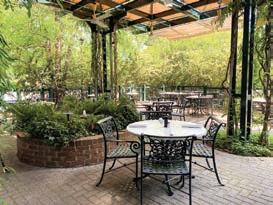



By Cynthi A A dA ms
My first trip to meet my new husband’s South African friends and family included days spent in Kruger National Park. “Park” sounds inadequate. It’s the size of Israel.
Upon arrival, park rangers handled admissions. Today, the 7,576-square-mile park’s entry fees translate to about $28. I can’t recall costs at the time, but it was easily half of that price. Tours are self- or ranger-guided, but we opted for self-guided, which fit our paltry budget.
The map, along with the ranger’s terse warnings, was free: Enter at your own peril.
Stay in your car with the windows up.
If you ignore that advice, beware: There are a number of wild, hungry creatures roaming freely within the park that would enjoy dining on you.
Be assured, you are on your own.
With that, we drove right in. On our own. Car windows, barely cracked open, turned us into a pre-warmed hors d’oeuvre for the ravenous beasties lurking about.

Unlike most public attractions in the U.S. with a slew of warning signs and legal disclaimers, South Africans treated park-goers like adults, assuring you that you alone bear the consequences of your choices.
True fact: More than 12,000 warning and safety signs are posted at attraction entrances in Disney parks and resorts. Litigious Americans apparently require them.
We were to remain on our own until reaching one of the park’s intermittent compounds, where we could either camp in a tent or, with a reservation, stay in a small, thatched-roof bungalow (called a rondavel) available for reasonable cost.
The famous game park was home to all “big five” — lion, elephant, buffalo, rhino and leopard. And, of course, giraffes. We proceeded to find a watering hole where we hoped to spot a big beastie.
Speaking of water: Yes, you are warned at entry not to leave
your car, but a day in a car without a potty break is impossible. And, at the time we visited, there were NO easily available restrooms. Just miles and miles of dirt roads. You seldom encountered humans along the way. But you just might find the road blocked by an elephant.
Possessing the bladder of a small child, eventually, I had to stop. Urgently, I summoned my husband to stand guard as I scanned the landscape, vitally aware that the greater number of the wild animals calling Kruger home were not altogether friendly.
Just after I dropped my shorts, he began waving wildly. Meanwhile, I heard nothing — no snapping of a twig, nor the padding of a paw. Thankfully, no snarling.
NOTHING but my own noisy flow.
My husband waved more frantically.
My heart stopped. But I was helpless in that moment.
He pointed madly behind me, mouthing something, and I was sure the lions we had been hoping to see since morning had instead found my white, shiny backside and were about to pounce on the snack I had witlessly offered up.
What an end, I thought, heart thundering. I'll never live this down, which, actually, would have been true had I been eaten while relieving myself in a public game park.
Imagine the TV reports. Imagine the stern faces of the park rangers, wagging a finger.
Shakily turning, still crouching, I observed that there was


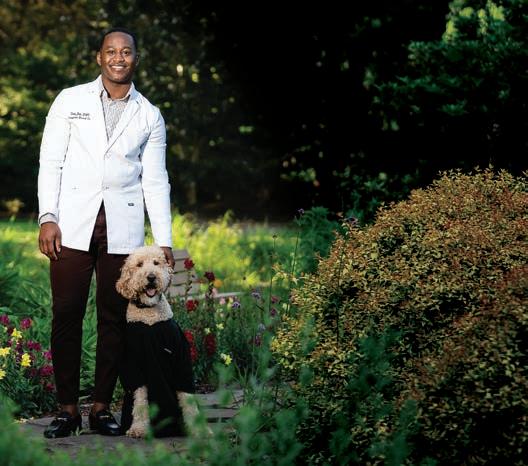
no big cat behind me — but two giraffes. Their impossibly slender necks were turned, their lash-rimmed eyes fixated. On me.
Know this: These are enormous animals. It was hard to breathe, given two competing thoughts: relief, given they were not aggressive beasties, and fear they would bolt. But the giraffes stood noiselessly, observing me as if amused, before they pivoted, moving away. Let me re-emphasize this: soundlessly
In a later trip to another South African public game park, we were again on the lookout for big cats when a group of giraffes came into view.
We stopped the car, admiring their balletic movements.
Then, without any ado, a female dropped her baby, giving birth where she stood, the calf dangling by the umbilical cord.
I imagine it is rare to witness the birth of a giraffe, but the mother seemed nonplussed. Within minutes, the calf seemed to find its wobbly footing and walked.

Inspired by this, we staked out another watering hole for hours, determined this was a harbinger; this time we might glimpse a big cat. Instead, what we encountered was a roving pack of peculiar wild canines also known as painted dogs.
The mangy-looking, elusive mongrels turned out to be an endangered species and highly protected for their rarity.
And rarely seen.
So help me.
“Tell us about the big game!” friends invariably asked when we returned. We raved about watching rhino. Elephants. Wildebeests. Impala. Springbok. Giraffe. And even unnerving encounters with green-and-black mambas. OK. So what if we didn’t see any lions? (Not then, nor on subsequent game park visits, FYI.)
And as their eyes widened, we dropped our biggest brag: wild dogs.
Like my trousers on that fateful day, their faces promptly fell. OH
Cynthia Adam is a contributing editor to O.Henry magazine.


















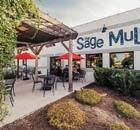


By susA n CA mpBell
Theblue jay is one of those species most of us instantly recognize: a common bird of woodland and backyard. But how well do we really know it?

This medium-sized, raucous bird can be found at feeders or flying around in treetops at any time of the year, but it hardly seems remarkable at first glance. It turns out that they are more complex and unique creatures than you might think.
Jays are closely related to crows, which are a highly evolved species. As a result, jays, too, exhibit a relatively advanced degree of intelligence. They have complex social systems. Blue jays remain together as a family for a relatively long period and also mate for life. These birds have dingy gray under parts and upper parts that are various shades of blue with gray and black markings as well as a blue crest.
Not only do they communicate with their voices, but also with body language. Changes in the jay’s crest are one of the most obvious ways they express themselves. Not surprisingly, it is raised when an individual is alarmed or is trying to be intimidating.
The unique black lines, or brindle pattern, on individuals is no doubt recognized by conspecifics. Interestingly, the pigment found in jay feathers is produced by melanin, which is actually brown. It is the structures on the barbs of the bird’s feathers that cause light to reflect in the blue wavelength.
In addition to their bright coloration, jays attract attention with their loud calls. They make a variety of squawks and screams, usually from a perch high in the canopy. Furthermore, they are known to mimic other birds’ calls, especially hawks. Whether this is an alarm tactic or whether they are trying to fool other species is not clear. The great early ornithologist John Audubon interpreted this as a tactic that allowed blue jays to rob nests of smaller birds such as warblers and vireos that were scattered by the hawk sounds. Modern studies of blue jay diets, however, have not found that eggs or nestlings are common foods. In fact, in feeding trials, this species is often outcompeted by other jay species, woodpeckers and blackbirds.
Another mystery is why, in some years, these birds migrate and some years they do not. Blue jays are particularly fond of acorns. So it may be that, in years when oaks are not very prolific, jays move southward in search of their favorite food. How many blue jays will remain in the Piedmont and Sandhills this winter will depend on the mast crop — especially the abundance of white oak acorns. These birds are very capable of gathering seeds in a specialized pouch in their throat and carrying them to nearby holes or crevices where individuals will stash them.
Blue jays have very definite nesting duties. Males collect most of the materials: live twigs, grasses and rootlets. The females create the large cup, incubate and brood the young birds. All the while the male feeds her and then forages for the tiny nestlings. Once the young have developed a good layer of down, the female will join the search for food for the rapidly growing family. It is not unusual for young jays to wander away from the nest before actual fledging occurs, though the parents are not likely to feed the begging youngster unless they return to the nest. It is during this period that people may “rescue” the wayward youngsters.
Finally, reports of “bald” blue jays are not uncommon. Do not be surprised if you see an odd-looking individual at a feeder or bird bath with virtually no feathers on its head, just dark skin. At first this was thought to be caused by feather mites that can be found on all birds to varying degrees. Now it seems there are simply individuals that lose all of their head feathers at once instead of in the normal, staggered fashion. This is more likely in adolescents who are undergoing their very first molt.
The next time you notice one of these noisy, crested blue birds, take a closer look. Blue jays are fascinating — and full of surprises. OH
Susan Campbell would love to receive your wildlife sightings and photos. Her email is susan@ncaves.com.















By Billy ingr A m
“Ah, summer, what power you have to make us suffer and like it.” —
Russell Baker
Seventy years ago, in the summer of ’55, a paddling of people numbering in the thousands, swimming-trunked with towels shoulder-slung and slathered in Sea & Ski, descended en masse for the opening day of the newly minted Lindley Park municipal swimming pool. It wasn’t long, however, before that above ground complex began making waves, awash in a clash of cultures that seemed to fall on waterlogged city leaders’ ears.
It’s one of our city’s loveliest and most serene neighborhoods, but, beginning in 1902 before any homes were ever conceived of there, Lindley Park was originally an amusement park, complete with a sprawling lake, casino, dance pavilion, 1,000seat vaudeville theater, miniature railroad, electric fountain and a cozy cafe. Live entertainment consisted of a trapeze act, a spunky monkey and a chatty parrot who likely ended up as a curiosity in the basement level of Silver’s 5–10¢ and $1.00 Store on South Elm and Washington.
The city’s first public park was named after J. Van Lindley, whose nearby 1,000-plus-acre nursery, established around 1850, was likely one of the largest in the world, with some 1.5 million plants under cultivation. Lindley lent 60 acres of the eastern end of his property to the Greensboro Electric Company with a proviso that they establish an entertainment destination there to coincide with the 1902 debut of the Gate City’s first mass transit system.
For less than a dime, commuters could trolley from North Elm downtown to the farthest western stop on Spring Garden Street, destined for the enchanted land of Lindley Park, where they could spend the day boating, swimming and tightrope gawk-
ing. Propelled along rails embedded into brick-lined streets and powered by overhead electrical wiring, a fleet of streetcars crisscrossed the city north to Sunset Drive, south down Asheboro Street (now MLK Drive), and both east and west on Market.
After the amusement park closed in 1917, Lindley gifted that real estate and another parcel to the city with a caveat — that a spacious, refined community be established there, designed by preeminent Southern landscape architect Earl Sumner Draper, who was behind Charlotte’s Myers Park and High Point’s Emerywood, among other tony neighborhoods. The lake was reduced to a creek with landscaped banks, making it a 107-acre verdant centerpiece to surrounding homes, soon to be constructed in a wide array of architectural styles, favoring Craftsman and Colonial Revival.
Endeavoring to reintroduce recreation to Lindley Park in 1955, the city sunk $200,000 into a public swimming pool designed to accommodate up to 800 sun worshippers, with 10 wide lanes for competition swimming and a cutting-edge aquatic sport scoreboard. There was one other city-owned pool in Greensboro reserved for the Black community built in 1937, located at Windsor Recreation Center on Lee and Benbow streets. After two Black women, Dr. Ann Gist and Ms. J. Everett, were turned away from the Lindley facility in June of 1957, the NAACP petitioned the city to integrate the pools.
Council members and apparatchiks such as Parks and Recreation commissioner Dr. R. M. Taliaferro voiced opposition to any attempt to abrogate the Jim Crow status quo. Current in their minds was the wanton unrest that erupted just a few Junes ago when Atlanta and St. Louis incited white rioters after their swimming pools were integrated.
Facing a potential unruly undertow that city leaders were loath to be swallowed up by, their initial reaction was to nuke the pools,







plow them under, before realizing that a legal loophole could serve as a flotation device. At that time, private entities were at liberty to discriminate indiscriminately, so it was resolved to offload these two chlorinated, all-of-a-sudden nuisances at auction, sold to the highest (like-minded) bidder, thereby surreptitiously preserving this pernicious practice. That brazen tactic triggered a preemptive lawsuit (Tonkins v. City of Greensboro) adjudicated downtown in the U.S. Middle District Court.
In May 1958, the court ruled in favor of the defendant but deferred dismissing the suit until 30 days after the sale of the pool “to give the plaintiffs an opportunity to show that the sale was not bona fide in the sense that there was collusion between the defendants and the successful bidder regarding the future use of the pool.” In other words, the plaintiff had a short window of time after the sale to prove it had actually been rigged by the city to enshrine segregation.
On June 3, 1958, J. Spencer Love purchased the “lake-sized” pool at Windsor Center, turning the operation over to David Morehead, executive secretary of the Hayes-Taylor YMCA. The Lindley Park aquatic center was acquired for $85,000 (only 3 years old, what a bargain!) by a hastily assembled coalition calling themselves Greensboro Pool Corporation, one of the organizers being none other than the aforementioned Dr. Taliaferro. No surprise, the Lindley pool would remain whites-only.
Did someone mention collusion? An appeal to Tonkins v. City of Greensboro was filed, one of the attorneys consulting on the case being future Supreme Court Justice and legendary Civil Rights leader Thurgood Marshall. Argued in January 1960, a ruling in March declared that the plaintiffs had not met their burden of proof. While recognizing that Taliaferro had openly opposed desegregating the property and was instrumental in setting up Greensboro Pool Corporation, the judge ruled, “he was a member of a nine-man commission, which serves in an advisory capacity only, legal authority



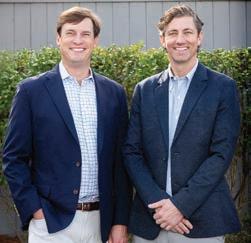






[for the sale] being in the City Council of which he was not a member.”
In 1967, just as an expanding, yet-tobe-named, Wendover Avenue (a road that began as a wagon trail rut in 1753) was carving away some 25 acres of the district, the City of Greensboro reacquired the Lindley Park Pool, making it accessible to all. A year later, a new swimming pool replaced the three-decades-old hole at Windsor Center, which, today, is being reimagined as the Windsor Chavis Nocho Community Complex, a 65,000-squarefoot facility with, among many other impressive amenities, a lap pool, lazy river and water slide.



Meanwhile, drowning under innumerable structural and mechanical quagmires, the Lindley Park Pool at 2914 Springwood Dr., now our city’s oldest, has been hung out to dry since 2023 but workers are resolute to rehydrate that concrete crate sometime this season.
Just this morning, I ventured out, hoping to uncover the one remaining remnant from Lindley Park’s initial 15 years as our nascent township’s sideshow. Not shy about wandering around, behind a hilltop home on Masonic Drive, I discovered a dollhouse-like, wooden women’s cabana with dual French doors that once sat lakeside.
Bracketing the neighborhood entryways off Spring Garden are matching stone monuments. Characterized by obelisks boldly asserting themselves where the amusement park’s mammoth arched gateways were positioned on either side of the lake, they were installed in 1924, when Earl Sumner Draper’s master plan was nearing completion. Over a century later, those monuments still warmly welcome visitors and residents alike to a shady little lady known as Lindley Park. OH
Billy Ingram is a regular contributor to O.Henry’s weekly email newsletter where you’ll meet fascinating local notables and explore hidden Greensboro hotspots. Sign up here: oheygreensboro.com




At Doctors Hearing Care, better hearing is always our focus. Dr. Amy Kirkland, Au.D. and Dr. Melissa Westall, Au.D. are committed to provide each patient with an exceptional level of care and attention. Together, they have been the triad’s leaders in hearing technology for over 28 years.












Sunday, September 21 • 2:00- 4:00 p.m.
The arrival of autumn means it’s time to think about snuggling into a cozy nook with a good book. O.Henry magazine proudly welcomes two distinctly different, yet both brilliant, USA Today-bestselling authors from 2–4 p.m., Sunday, September 21, at Grandover Resort & Spa.
Historical fiction your genre? Winston-Salem’s own Sarah McCoy is the New York Times-bestselling author of 8 books, including her forthcoming Hollywood-starlet-turned-nun novel, Whatever Happened to Lori Lovely? Looking to dig into a mysterious thriller as the days draw darker? Hank Phillippi Ryan is the USA Today-bestselling and multi-award-winning author of 16 psychological thrillers, including her forthcoming All This Could Be Yours; plus, she has won 37 Emmys for TV investigative reporting. Enjoy a catered spread and sips, then sit down for a conversation with both women as we discuss research, inspiration and the writing process. Double the fun!
Tickets: ticketmetriad.com
Book your tickets today at: Supported by:




In myths and poems, it keeps company with the rose. Cold scythe of winter. Hammock of summer. There’s no eclipsing its power over the sea. In the game of hearts, we “shoot the moon,” while each new phase of darkness smolders with anticipation. Our yard trees may fence us from it, but waxed full, it offers delivery with argent bath of light. Mystics’ elixir. Astrologers’ purlieu. The moon harvests our dreams.
— Elizabeth W. Jackson
Elizabeth W. Jackson is a practicing psychologist and writer whose work has been published in journals, anthologies and a chapbook.

The Discovery Channel’s Shark Week began on a napkin in a bar. Stephen King jotted down his notes for Misery on airplane napkins on a flight to London. The design for the first MRI scanner was drawn on a napkin in a Pittsburgh hamburger joint. Aaron Sorkin wrote A Few Good Men on cocktail napkins during the first act of La Cage aux Folles when he was working as a bartender at the Palace Theatre in New York. The scout for the Barcelona football club was so worried a young Lionel Messi might get away that he drew up their first contract on a cocktail napkin. Because good things do come in small packages, we asked seven of our favorite authors to invent a napkin-worthy story to help us through another hot August. Relax and enjoy.

A writer of both fiction and nonfiction, Dana Sachs teaches at UNC Wilmington and is the author of If You Lived Here and The Secret of the Nightingale Palace.




A member of the North Carolina Literary Hall of Fame and the recipient of a Guggenheim Fellowship, Clyde Edgerton is the author of The Bible Salesman and Walking Across Egypt.


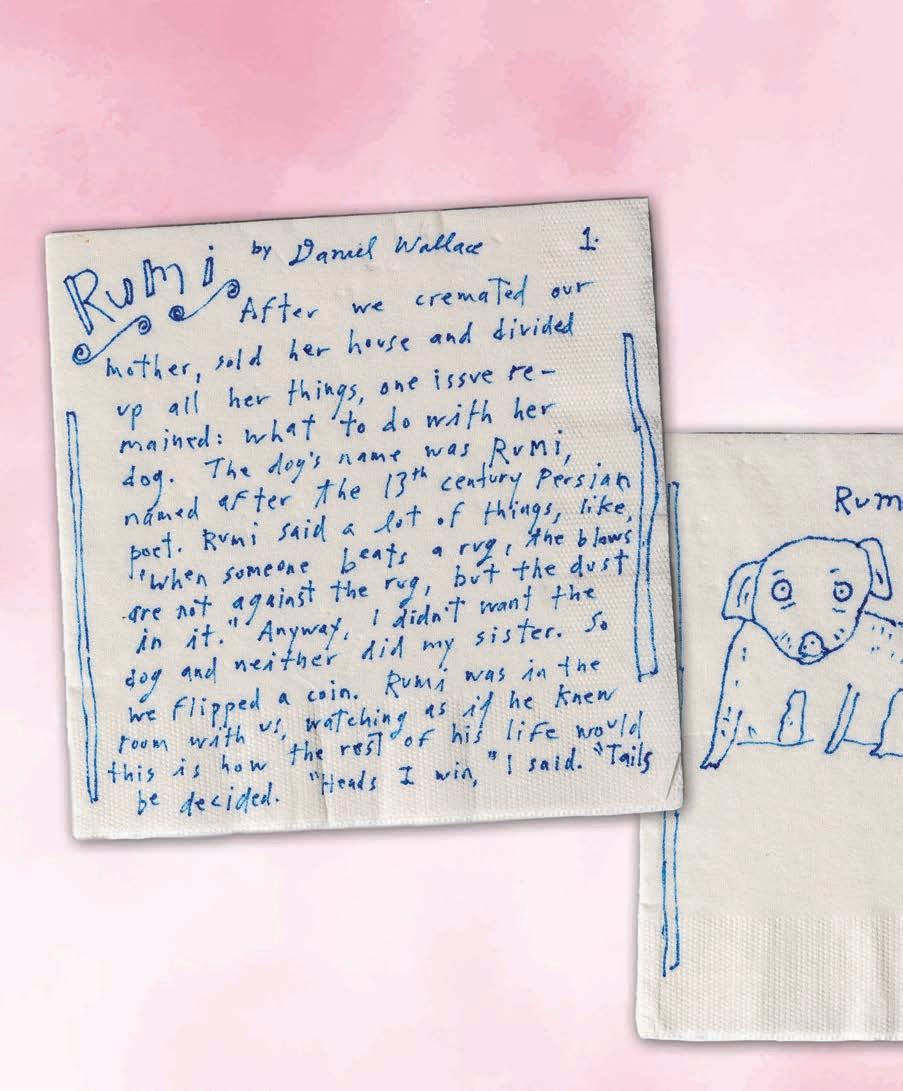
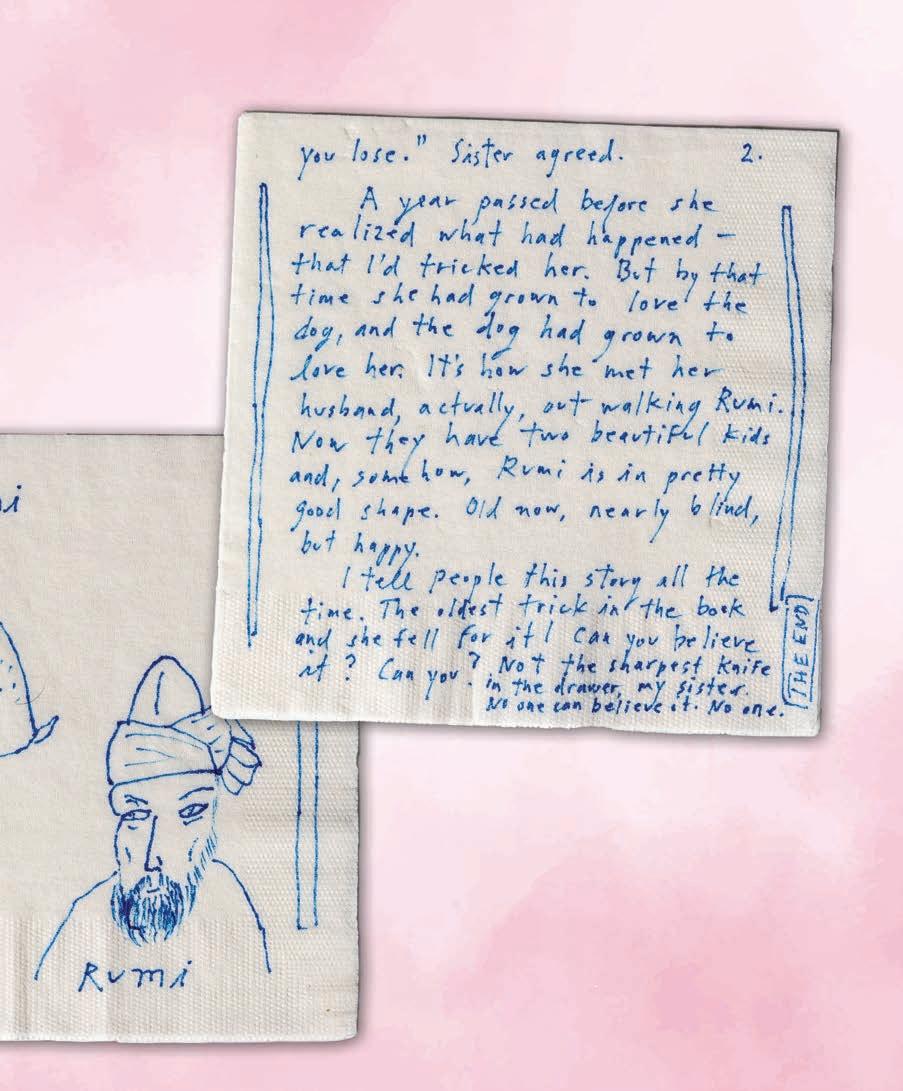
Recipient of the Harper Lee Award, Daniel Wallace is the author of Big Fish. His most recent book of short stories is Beneath the Moon and Long Dead Stars

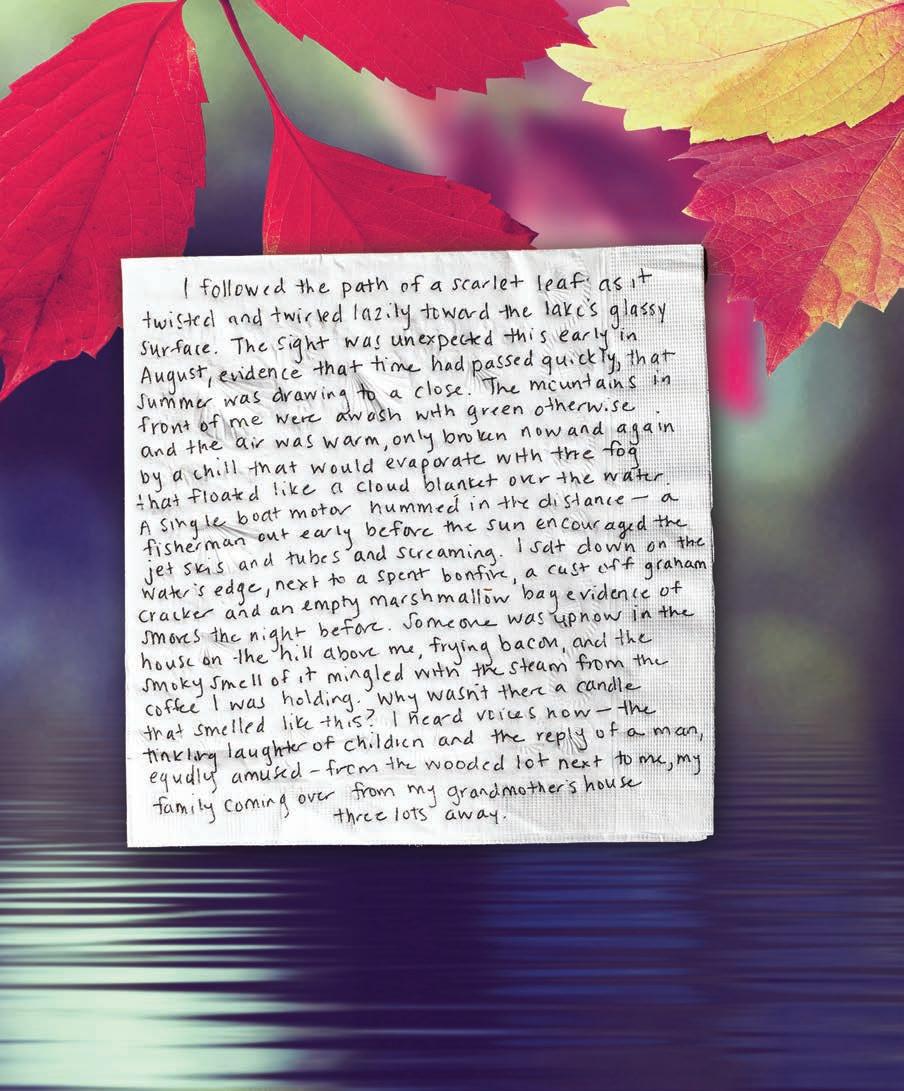
An international bestselling writer, Joy Callaway is the author of The Star of Camp Greene and Sing Me Home to Carolina.




The winner of both an Agatha Award and an Edgar Award, Sharyn McCrumb is the author of The Unquiet Grave and Prayers the Devil Answers.


Nominated for a Pushcart Prize, Naima Coster is the author of Halsey Street and What’s Mine and Yours.




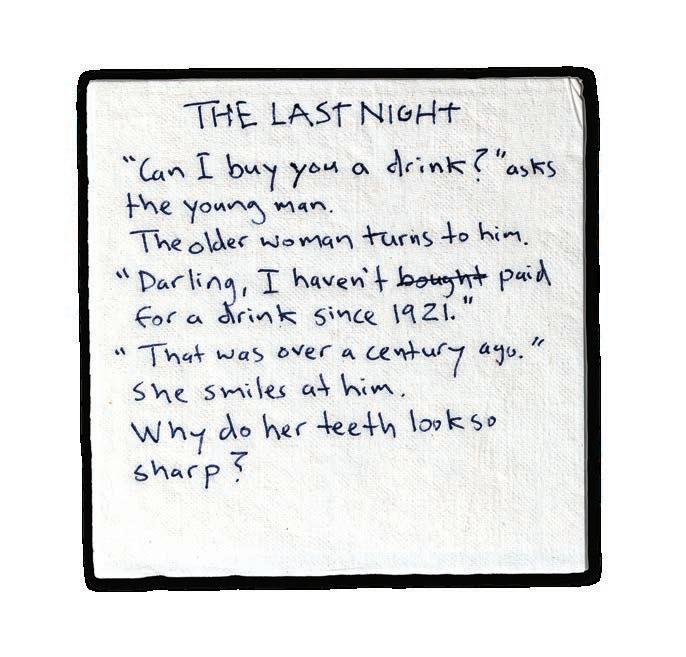

the
in


By M aria Johnson
PhotograPh By Bert VanderVeen

omeone sets a cup of coffee on the roof of their car.
They get distracted.
They drive off, cup still on top of the car.
This all-too-human scenario tickles cartoonist Tim Rickard as he picks up his stylus and starts doodling.
What tickles him more is the possibility of this uh-oh moment happening in outer space, specifically in the world he has created for his syndicated comic strip, Brewster Rockit: Space Guy!, which is named for its protagonist, the strikingly handsome and equally clueless commander of the space station R.U. Sirius.
In the 21 years since Brewster and his crew of cosmo-nuts first appeared in publications around the country, Rickard has blasted them into deep-space silliness thousands of times. He draws six strips a week: one for every weekday, plus a standalone for Sunday.
The strip appears in the funny pages of major publications, including The Washington Post, the Chicago Tribune and the Atlanta Journal-Constitution.
He’s talking about Rickard, whom he credits with otherworldly talent.
Brewster is another story.
“Brewster never intends to be funny,” adds Rayman. “He’s not smart enough to be funny. But I admire his biceps and his jaw.”
Where would the ill-fated coffee cup be? Rickard wonders how to transport the commuter gag into Brewster’s world.

He sits at a desk in his home office, where he has worked since 2020, when he was laid off by Greensboro’s News & Record newspaper after 27 years as a staff artist.
He slides a stylus across a graphics tablet.
Lines appear on the 24-inch screen in front of him.
He roughs out the R.U. Sirius and places a coffee cup on top of the space station.
Nah, he decides. The cup is too small relative to the station.

While Brewster is a tyke compared to some longstanding cartoons — Rickard’s broker, Tribune Content Agency, also represents stalwarts Dick Tracy, Broom-Hilda, Gasoline Alley and Annie — the commander’s longevity is a stellar achievement in the universe of syndicated strips, where the average feature lasts 10 to 15 years.
One key to Brewster’s endurance: a fan base that includes the professionally spaced-out.
“I love the way he manages to be informative and funny,” says Marc Rayman, the chief engineer for mission operations and science at NASA’s Jet Propulsion Laboratory in Pasadena, CA.
Rickard, who resembles a salt-and-pepper version of the boyish Brewster, deletes the scene and starts over.
He draws a pointynosed rocket zipping sideways through space and outlines a coffee cup on top.
Nope. Still not right. Delete.

His mind and his hand keep moving.
He was a scribbler.
You know the one: The kid who draws on every napkin. Every flyleaf. Every sidewalk.
Rickard’s dad liked to tell the story of going into an Owensboro, Ky., cafe in the wintertime and watching his son, then 4 or 5, draw with his finger on the steamy windows.
Rickard, 66, who has been a member of MENSA, the high-IQ club, for about 40 years, looks back on his younger self with a mixture of humor and compassion.
Several years ago, he says, he realized that he’s probably on the high-functioning end of the autism spectrum, along with many others who excel in the visual arts.
As a youngster, he was plenty smart intellectually, but talking with people face-to-face was challenging. Communicating with pictures — with the chance to draw in solitude, erase and redo —
was much easier.
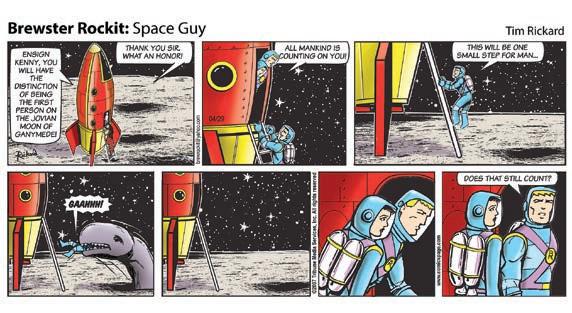
He went to Kentucky Wesleyan College to study art, with an eye toward advertising. A couple of internships and freelance jobs later, he decided that working for a newspaper, on the editorial side, would offer more variety and freedom.
He joined his hometown paper, the Owensboro MessengerInquirer. A couple of years later, seeking a bigger paycheck, he signed on with the News & Record. His portfolio expanded to include courtroom sketches, editorial cartoons and illustrations for stories that did not lend themselves to photographs.
He also started a weekly comic called Joke’s on You, a singleframe feature that showed characters in situations with no dialogue. Readers competed to provide the winning captions.
Summerfield veterinarian Tim Tribbett won 32 contests, more than anyone. One of Tribbett’s favorites showed a mama bear and baby bear gazing at a bearskin rug on the floor of their home.
“Couldn’t we just keep a photo on the mantle?” the cub asks in Tribbett’s caption.
Every week, Rickard sent the winner a signed, printed copy of their entry along with a note of congratulations. The strip provided a community for participants.
“We never met, but we felt like we knew Tim, and we knew each other a little bit,” says Tribbett.
When Rickard left the newspaper during COVID, about 20 faithful contestants threw him a party at a local park. They brought a cake topped with an edible image of Rickard’s work.
“The contest meant a lot to us,” Tribbett says.
Rickard is still pondering where to put the coffee cup.
Atop a small flying saucer?
That would be comparable to a car.
He sketches a small, sporty saucer with a clear dome. The coffee cup appears on top.
Bingo.
More questions blossom in his head: Who is inside the saucer? How many characters?
Is there dialogue between them?
Two aliens appear inside the bubble.
“You left your coffee on the roof again?” one says to the other. Rickard studies the scene.
It’s OK.
But just OK.
Drawing a strip that appeared in funny pages nationwide — that was the goal.
Rickard started submitting ideas to syndicates when he was in high school.
Rejections piled up, but some contained a grain of encouragement.
“Not bad.”
“You’re a good gag writer.”
It was enough to keep him going.
He knew his ideas were derivative, hewing too closely to existing strips. He needed something fresh.
Long a fan of Star Trek, Star Wars, the Marvel catalog and monster movies, he was at home in fantasy worlds. But Earthly wisdom held that space-based comics didn’t fly, and Rickard was loath to try sci-funny until rejection pushed him to give it a whirl.
“I figured if I was gonna fail, I might as well fail doing some thing I want to do,” he says.
That’s when Brewster came to visit. Rickard was in his early 40s.
Drawing late at night while his family slept, he invited the hapless captain into his head to play. Soon, Brewster showed up with other characters, including Brewster’s very competent wife, Pamela Mae Snap; Dr. Mel Practice, the station’s crazed chief scientist, whose inventions include the Procrastination Ray; and Dirk Raider, a former member of Knights who had crossed over to the sinister Microsith corporation.
Rickard drew his characters in a realistic style reminiscent of soapy comic strips Steve Canyon and Rex Morgan M.D.
His concept — that Brewster and his goofy sidekicks


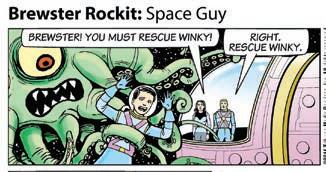
protected the Earth from evil— was funny on its face, and it provided a lot of room for storylines.
In early 2003, Rickard sent samples of Brewster to three syndicates. Two replied with nays. The third did not respond. Rickard assumed that meant “no.” He let go of his dream.
A couple of months later, the third syndicate replied. They wanted to see more.
Rickard sharpened his strip according to the editors’ suggestions, and Brewster joined the fleet of Tribune comics in July 2004.
NASA’s Rayman saw the strip in the Los Angeles Times soon after it launched.
Brewster’s mix of scientific literacy and everyday nincompoopery impressed him and his real-world rocket scientist colleagues.
“Many of Tim’s comics — in fact, most of them — don’t have anything specifically to do with space,” Rayman says. “Like any creative artist, he uses the context he has created to cover many different subjects.”
Still, Rayman admits, he’s thrilled whenever Brewster mentions a mission that Rayman is actually working on, as happened in 2007, when the strip referred to DAWN, a probe that investigated the asteroid belt between Mars and Jupiter.
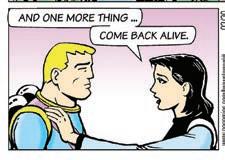

Rayman contacted Rickard to suggest, in jest, that he should ask Brewster and crew for advice. Rickard was game. He incorporated Rayman and a legit question into a strip. Several characters offered lame words of wisdom.
Rickard and Rayman have been collaborating ever since. Rayman fact-checks some of the weekday strips, and they share responsibility for Rocket Science Sunday, an occasional educational version of Brewster.
“He’s extremely open to my comments and feedback,” says Rayman. “There’s no ego to hold back the quality.” Or the buffoonery.
In Brewster’s world, Earthlings can escape gravity but not their foibles.
“The strip never feels like it’s talking down to anybody because the characters are so flawed and stupid and lazy,” Rickard says. “The reader is always in on the joke.”
Ideas come from all directions: news, science, popular culture.
Sometimes, Rickard’s own life seeps into the frames. After he
had his first colonoscopy, so did the character named OldBot.
Once, an enemy storm trooper asked his daughter for help with his phone — a copy and paste of Rickard asking his own daughters for technical assistance.
Also, Brewster made a list when Pam asked him to complete more than one task.
“That was literally a conversation with my wife and me,” Rickard says.
In 2010, he and his syndicators traveled to Hollywood to pitch an animated movie based on Brewster, who appeared in 150 markets at the time.
Nothing came of the meetings, but the comic kept cruising.
Last year, The GreenHill Center for NC Art included more than a dozen Brewster pieces in a show of science fiction works by artists statewide.
Rickard relished the sight of Brewster on the walls of the tony gallery.
“He seemed totally out of place,” he says, chuckling.
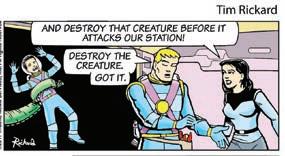
Where might Brewster materialize next?
Rickard shrugs. He’d like to do another best-of book. A 2007 paperback collection subtitled Closer Encounters of the Worst Kind is out of print but fetches healthy resale prices.

As for the daily offerings, Rickard repeats his industry’s biggest non-secret: newspapers and other traditional customers are dwindling. The News & Record dropped the strip after they laid off Rickard.
One day in the not-so-distant future, Rickard says, Brewster might cease to dwell on paper, his original home, and live only online. Already, the strip appears at gocomics.com, an internetonly repository of cartoons past and present.
In a way, a total shift to cyberspace would make cosmic — and comic — sense.
Rickard says Brewster and his creator are ready to adapt.
“It’s always been a forward-looking type of strip, so the fact that that would be the inevitable home for him would seem appropriate,” Rickard says.
He deletes one of the aliens in the flying saucer.
The one-liner, “You left your coffee on the roof again?” disappears, too.
Only the driver of the saucer remains.
Rickard re-draws the alien’s head. Now he looks up at the cup through the clear roof of the craft.
A thought bubble appears.
“Oh, no. Not again.”
Rickard sits back and puts his stylus down.
That works. OH
By Danielle Rotella aDams

inding down the sloped, two-lane road into downtown Elkin, the Blue Ridge Mountain majesty emerges as an unexpected backdrop. On a clear, sunny Friday, my husband, Tom, and I travel past grand, centuries-old Victorian homes that line the streets. Sprinkled among them are charming, 100-year-old Craftsman-style bungalows with intricate stainedglass doors and wide, red brick columns. It’s easy to imagine neighbors visiting each other’s porches, drinking fresh-brewed sweet tea on blistering summer days.
Just 65 miles from Greensboro, Elkin offers a slower pace where history and creativity are a way of life.
As we slow down to park, an enormous mural serves as a sort of welcome sign. Chapel Hill artist Michael Brown, whose work can be found locally at the Greensboro Public Library’s rotunda, has painted a landscape of perfectly lined grape vines set against Stone Mountain and a cloudy, Carolina-blue sky in the background. Business owners in Elkin have been adding their own murals to the blank sides of their buildings since 2012 as part of the Mural Grant Program, bringing a bit of whimsy to the “Best Little Town in North Carolina,” a slogan dating back at least 100 years.
Arriving at lunchtime finds us ducking into a scrumptious farm-to-table feast at Southern on Main, a hometown favorite
that proudly displays art for sale. Vibrant bluejay canvases pop against the wood-beamed walls.
Marvin Gaye’s “Take This Heart of Mine” plays faintly in the background as our cheery waiter, Dennis, reaches our corner patio table, holding a tray of starters — hot bubbling Gouda mac-and-cheese, tangy, crisped-to-perfection Brussels sprouts, and creamy deviled eggs. His eyebrows inch up when we decide to pile on the enticing blackened catfish and chicken pot pie. Our bellies filled with Chef Marla Egger’s seasonal, Southern fare, we set off to see what else Elkin offers.
Walking past an old train car, we soon arrive at the Yadkin Valley Heritage & Trails Visitor Center at 257 Standard St. Another massive Michael Brown work highlights the story of the Revolutionary War’s Overmountain Men, who crossed the Yadkin River on their way to King’s Mountain, S.C. Inside, we learn how far back Elkin’s history goes, back to when Sioux Indians settled along the Yadkin River as early as 500 B.C.

Next, we trudge up steep Church Street to admire the quaint Richard Gwyn Museum at 139 Church St., built in 1850 by Gwyn himself, Elkin’s founder. Although closed, we peek inside the tiny, wooden one-room schoolhouse, where a single teacher educated children of all ages and grades together.
Gwyn established the town’s first and most influential industries — a gristmill and a cotton mill, later sold to the Chatham family. The Chatham Manufacturing Company started producing wool Civil War uniforms, blankets for soldiers in World Wars I and II, and, later, car upholstery.
History, check. Next up? Shopping! We head back to Main Street, where flowering perennials and annuals spill out of the tops of oak barrels carefully placed on street corners, featuring handwritten directional signposts to help visitors find local spots. Suddenly, we realize that we’re trekking down the Mountains-toSea Trail (MST), a small segment of the footpath that stretches almost 1,200 miles across North Carolina.
Walking into Wildflower DIY Bar makes me smile. Owner
Laura Wood sits at a large table surrounded by assorted paints, probably studying her next project. She opened Wildflower more than 10 years ago and migrated to different locations before landing at her 111 W. Main St. spot, where she teaches classes, hosts parties and sells local paintings, beading, and handmade whimsical creations. A self-taught artist, Wood grew up in Elkin and worked in mental health, where she found that her students with disabilities discovered their inner beauty through art. She now helps others find their creativity in a myriad of ways.
“There’s a lot of art, culture and history in Elkin,” Wood shares. “Everyone knows everyone, too, and if you need something, someone will help you out.”
Continuing down the main drag, we pass Michelle’s Consignments and Yadkin Valley Fiber Center, before stepping into Candles Etc. As indulgent, floral fragrances fill my nostrils, owner Kerri Ramsey greets us near the door, sharing how her Earthfriendly, soy candles are all hand-poured on site. She opened her shop in 2024, but sold candles before then at nearby wineries, where she also offers onsite candlemaking classes. No way I’m leaving empty-handed. I load up with an Elkin Rainstorm candle, glass matchstick holder, and “Take a Hike!”-etched candles. Ramsey then shows me her favorite seasonal selection, so I pile on Holly Jolly Gingerbread and Cranberry Spice candles. Fall is just around the corner, after all.
On the other side of Main Street, we tour Demo’s Art Loft, located inside Kennedy Auto Antique Shop. Walking into the antique shop feels like stepping back in time, merchandise stretching as far as the eye can see, possibly from all the decades the shop has existed — seven, to be exact. After meeting Maggie May, the owner’s long-haired dachshund and obviously the store’s security detail, I walk upstairs to meet artist Geoffrey Walker and leave Tom downstairs to see if there are any nostalgic relics he can’t live without.
Walker, who opened his store in 2017, uses different mixed media, from graphite, ink and watercolor to 2D and 3D printing and woodworking. He has a knack for landscapes, portraits and
unique anime creations. After I buy three of his framed prints, he asks, “Do you want to see the phonographs downstairs?” Meeting Tom back at the main level, the three of us venture to the basement, where a treasure trove of beautiful, ornate, hand-cranked phonographs from the early 1900s awaits. Their intricate oak and mahogany cabinets are etched, some with decorative red roses and green vines.
“I learned by seeing what they do, trial and error, and talking with other people,” Walker happily remarks.
“The spring,” he notes, “is the main thing that needs repair — it has fatigue over the years. Sometimes it’s a simple fix.”
Speaking of “fix,” the smell of freshly roasted coffee beans lures us into Milk & Honey Coffee Company on West Main Street for a subtle jolt of post-shopping caffeine. Opened in 2025 by baker Faith Stone and her coffee aficionado husband, Sam Stone, the shop’s ornate
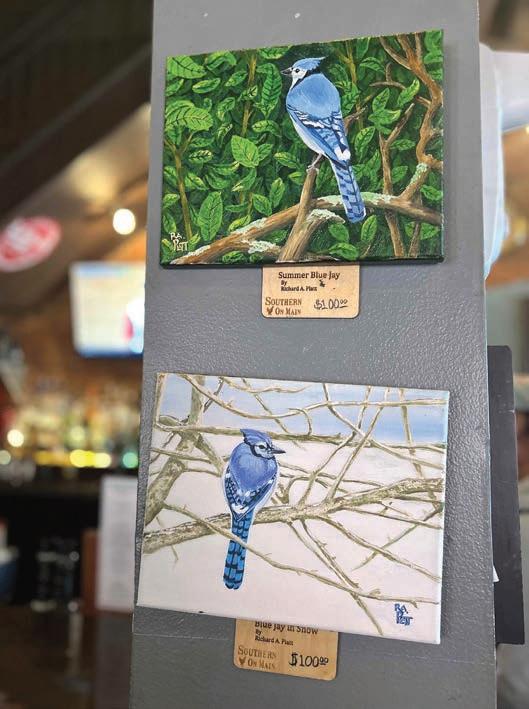

chalkboard menu offerings scratch our itch. More caffeinated specialties can be found at Garden Route Coffee, owned by Tina and Rod Poplin, former missionaries in South Africa who fell in love with local, high-quality coffee. After sipping on a delightfully creamy Honeybee Latte and noshing on a buttery, homemade Berry Pop Tart, we follow our ears to the downtown music scene.
We just so happen to stumble upon Friday Night Live at Reeves Theater, which brings live music to different spots downtown, April through October. Tonight, Couldn’t Be Happiers and Catastrophe Journal, both from Winston-Salem, fill the Art-Deco style movie house with indie-folk and indie-pop sounds. We order glasses of Shelton Vineyards Bin 17 Chardonnay from the theater bar and tap our feet to high-energy originals.
Opened in 1941, the 250-seat theater underwent several iterations before three devoted Elkin residents, Chris Groner, Debbie Carson and Erik Dahlager, turned it into a live music venue in 2013. Free Music Wednesday is offered year-round. The Martha Bassett Show records live every other Thursday, and ongoing jams can be enjoyed by The Reeves House Band.
Finally, our tummies are rumbling again, and we venture to Angry Troll Brewing, the town’s homegrown local microbrewery and restaurant. A renovated textile warehouse with tall, wood-
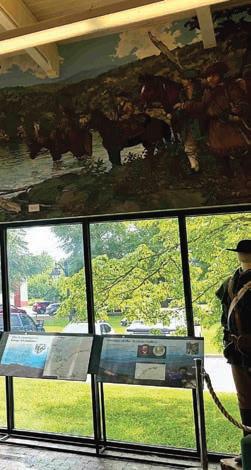
beamed ceilings, exposed brick, and numerous TVs, we opt for a steaming-hot sausage pizza and garlic buffalo wings, washed down with Orange Goblin Ales. Despite its name, which is derived from the storybook troll whose bridge was demolished, Angry Troll has a warm, welcoming vibe. We can’t help but sing along with the ’90s tunes.
Not ready to tap out quite yet, we visit Embers Eclectic Pub,


another popular watering hole on West Main Street. The pub name is inspired by an Irish proverb about finding lasting love, which seems to have been attained by owners and marriage partners Dylan Hayward and Alexis Usko, who moved to Elkin in 2016 and opened their locally adored spot six years later.
After a full day, we’re asleep as soon as our heads hit the pillow at Three Trails Boutique Hotel, a renovated historic building with studios, one-, two-, and three-bedroom units, several accessible options, and a stunning rooftop patio overlooking downtown.
After grabbing a quick breakfast the next morning at the Elkin Farmers Market, we buckle up and begin our short drive back home, the grape tree mural fading in our rearview mirror. But it’s not goodbye for long — I’ve already marked my calendar for next month’s Yadkin Valley Pumpkin Festival. OH
Danielle Rotella Adams is a freelance writer living in Summerfield. When she’s not writing, she enjoys spending time with her family and friends, traveling and being outdoors.

By Cynthia a da Ms • PhotograPhs By John gessner
Margie Benbow did not grow up on a farm. But the easygoing former urbanite says, “I wanted to be a ‘country’ Benbow.”
And so she is, living contentedly in a traditional, white clapboard farmhouse nearing a century old. One with generous porches and a wideopen view to acreage planted in fescue and flowers.
Wearing a denim dress with overall straps, Crocs sandals and a red bandana holding back her blond hair, you might guess she has known nothing but life on a Summerfield farm. But you’d be wrong. She is a scientist, lawyer, auctioneer and artist — now farmer — joining the ranks of 24,160 women farmers in North Carolina, where the percentage of women jumped 90% in recent decades.
She’s downright Jeffersonian in her wide-ranging ambitions, not only practicing law while farming, but simultaneously making a serious run at political life last year. No mat-

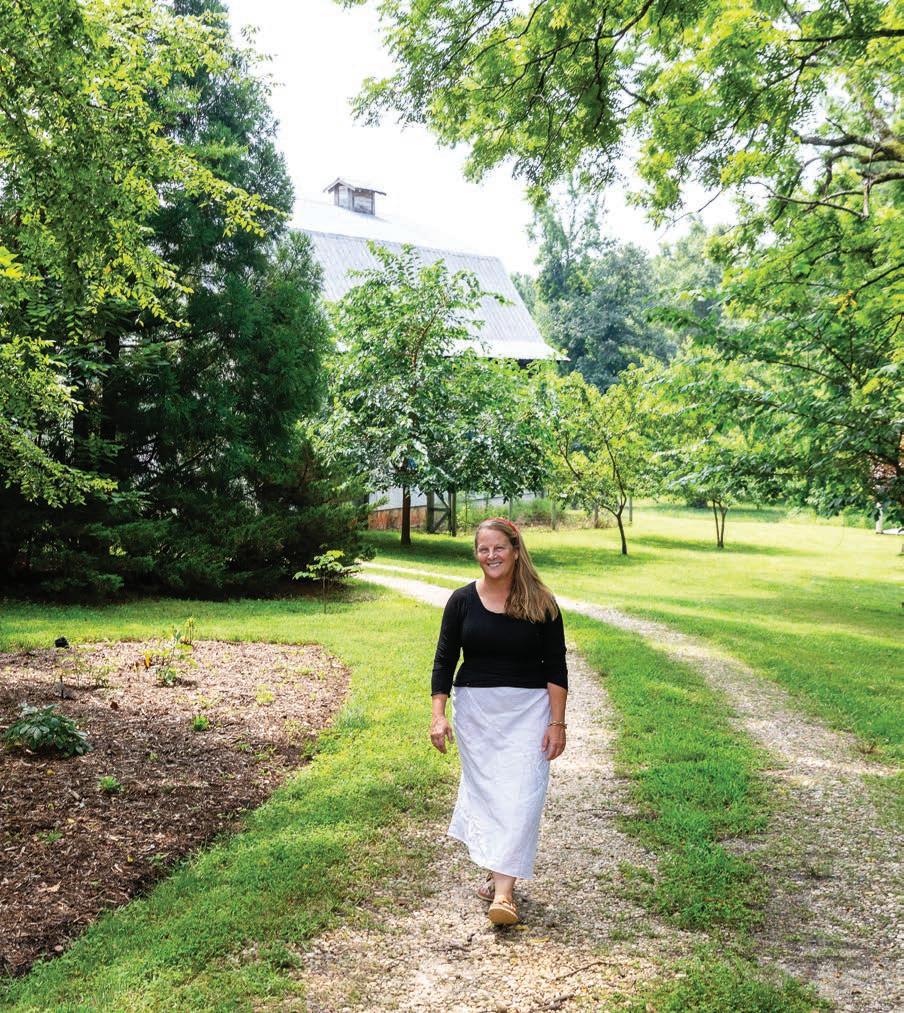

ter that she lost her race for the North Carolina House of Representatives; Benbow maintains a natural sunniness, a goodwill that makes even her losses look like wins.
This is decidedly her super power.
If any of her dreams were easy, she probably wouldn’t even have found them very interesting.
Nine years ago, Benbow said goodbye to the din of traffic and all that comes with it, having lost her physician husband, Dr. Hector Henry, to cancer. Court dockets no longer ruled her calendar — just before the pandemic, she had settled into a rural rhythm largely dictated by Mother Nature.
She acquired not one, but two farms — another is a leafy drive away in the tiny community of Bethany, population 362.
Summerfield, by comparison, is practically a bustling suburb of over 11,000 residents. This, she laughs, is her city residence.
Wandering into the kitchen to prepare a ginger tea,
Benbow appraises the space, which is open and oriented to the farmland behind the house. Even inside, she can keep watch on her crops from the dining room table.
She came of age in a pleasant Winston-Salem neighborhood as a “city” Benbow, with three sisters and a brother, relishing visits with the family’s “country” kin. She confides having always envied the life of her counterparts.
She ruminates about the reasons she is smitten with being far from the maddening horde.
“They had a pond. Since I was 4, I’ve wanted this life,” she declares.
Now she, too, has a pond of her own at the Bethany farm near a log cabin where restoration is underway. As further proof of self-reliance, Benbow has tasked herself with learning to make a split-bamboo fly rod — should she ever want to cast off. Online tutorials are daunting. But, then, that probably just whetted her appetite to learn.
In Summerfield, she has created a sunny, happy haven,

the rooms dominated by whimsical, colorful art.
“This is my city house,” she teases, nary a neighboring house in sight. “My country house is 4 miles down the road.” She first bought the Summerfield house and 20-acre farm in 2016.
The second farm, bought in 2020, sold at auction. Benbow was the top bidder. Land, she explains, is an addiction.
Then, the pandemic struck and a lockdown ensued. She realized she was going to have more than a small amount of isolation, even in what she calls her “city” house because of its proximity to Summerfield. She admittedly binge-watched Netflix and ate popcorn.
But also, she got busy.
As an avid artist, Benbow weighed the overall aesthetics of the house where she had moved.
“It had amazing bones.” The kitchen, centrally located and serviceable, made sense to leave much as she found it, preserving the existing layout. The
space includes four sets of doors making it lightstruck and airy.
But Benbow explains that the farmhouse was a less daunting project than the restoration of the farmlands whereupon it sits. Much had already been accomplished in the house when she acquired the property, she says. Essentials, like replacing windows. But some things were neglected, like the disintegrating fireplace bricks.
Then she considered ways she could inject her own style. The cosmetics could use some help, she decided. Benbow ripped out the kitchen tile, designing and crafting her own backsplash tile at the Sawtooth Center in Winston-Salem. A hefty butcher’s block, repurposed as an island, required six people to move in as well as joist reinforcement. But once in place, it looked as if had always been there.
The open kitchen, now suitable for a serious cook, features a professional range. But when ques-


tioned about cooking, she laughs. “It looks like a cook’s kitchen.”
Cooking? Not her thing.
Benbow points out the most-used “fancy” appliances, giving a throaty laugh: a toaster, a popcorn popper, a Ninja juicer and a coffeemaker.
“That’s about it.” Still, she agrees. The range looks great. As a rule, where Benbow found original farmhouse details, she kept them. But the ugly and unoriginal popcorn ceiling and cheap light fixtures had to go. Mostly, she “just made it pretty. Calmed it down.”
Since moving here, she has accomplished a lot, steadily ridding the surrounding land of tangled overgrowth. In order to grow flowers (focusing upon pollinators, a passion) she tackled clearing the fields of seven years of tree growth.
Afterward, she used the sawdust from removing all those trees, recognizing it as a compatible medium for planting zinnia. But a storm made short work of her investment in seeds, fertilizer and lime — all laid to waste.
Undaunted, Benbow acquired her second, 50-acre farm using new auctioneering skills from Mendenhall School of
Auctioneering. A slew of projects came with the parcel — outbuildings, a log cabin, even a country store. She keeps horses there in a fine new equestrian barn. A mare, she says proudly, recently foaled.
The dream, however, follows a personal tragedy. She and her late husband were birds of a feather. The doctor, medical professor and long-time member of the city council in Concord, was a Colonel in the U.S. Army Reserves Medical Corps. (He made headlines volunteering for multiple Middle East deployments when well past retirement age.)
Benbow reminisces about their meeting at Duke when she was a graduate student working in a lab and he was doing morning rounds as a pediatric urologist. (She nearly went on to medical school.)
Henry had surreptitiously “scoped her out” as she demonstrated to residents how to do cell cultures.
Initially, she was reserved, questioning how he obtained her number when he called her. He thought she might be an ice princess.
Before dating, she grilled Henry.


Had he ever done drugs? Was there another woman that would mind her having dinner with him? And, out of curiosity, what was his age?
“He answered no to the first two.” The age difference didn’t matter.
Three months later, they were engaged, marrying in 1992. She muses about the fact that only one of her four siblings didn’t pair up with a doctor.
Seemingly indefatigable, Henry died on Thanksgiving Day in 2014 at age 75 due to complications from a rare blood cancer. Her smile fades. For seven months following, she describes being “spiritually diminished.”
With Henry’s death, Benbow was forced to begin anew. She literally replanted herself.
Behind her Summerfield farmhouse, a colorful vista unfolds in summer. While she isn’t particularly good with flowers, Benbow shrugs. “I just try.”
Benbow has walked each furrow and hillock.
“Goldfinches, butterflies, all did well,” she muses, pleased that pollinators are appearing — even as she worries about their
general decline. She is consumed by the need to support pollinators and began beekeeping, but lost her hives this past winter during severe cold. Still, there are emotional victories. It was a special moment watching deer wading into the sunflowers she had planted.
For someone who was first a scientist, she explains farming, too, is process dependent.
“You have to get into the process, and pray for the outcome. ‘I hope it works,’” she jokes, but is also serious.
Benbow recalls telling Rotarians just how humbling and uncertain it is.
“If you want to find religion, sit on a tractor thinking about those seeds you just spent $4,000 on,” she says, adjusting herself in her chair as if sitting atop a tractor: “You sit on that thing [hoping]. ‘It’s going to work. It’s going to work.’ And pull in all the good vibes of the universe.”
Last year, she lost both sunflowers and corn crops to drought. Losses are a piece of the human condition, as she is acutely aware. As for the romantic culture of growing what you eat and farm-to-table fantasies, she also understands how hard it is.

Even basic crops like tomatoes, planted in the same place again and again, lead to soil depletion. Crop rotation is essential. She quickly outgrew the first farm — so acquired another.
With hands thrown up in a gesture of surrender, she laughs about how her best tomatoes are often volunteer plants randomly emerging from the seeds of tossed-out tomatoes. “With no memory of a potential pathogen there,” the science-minded farmer explains. The tenuous balance of earth and farming is a constant seesaw.
If enduring disappointment and difficulty prepare one for the unpredictability of farming, Benbow’s own childhood easily predicted the success of her marriage. Battling adult polio at age 25, her father endured 13 months in an iron lung when his wife was pregnant with their second child. Later, he adapted to walking with leg braces and refused to be a victim. He went on to create
the first computing department at R.J. Reynolds.
He was never self-pitying, Benbow recalls.
Her mother, Jane, was a cartoonist in college yet skilled in math. Her father, William, was a poetry-writing engineer. A single thing didn’t define them.
She inherited both left- and right-brain talents from her polymath parents. And — a happy resilience that seems indomitable.
For a time after Henry’s death, Benbow was adrift, listening for an echo that was no longer there. Coping with not being part of a duet is painful.
“Much like in The Magic Flute,” she explains, “when the songs echo.” She confesses to “having leaks” when something triggers tears.
Alpha Awareness Training by Wally Minto led to recovering herself.

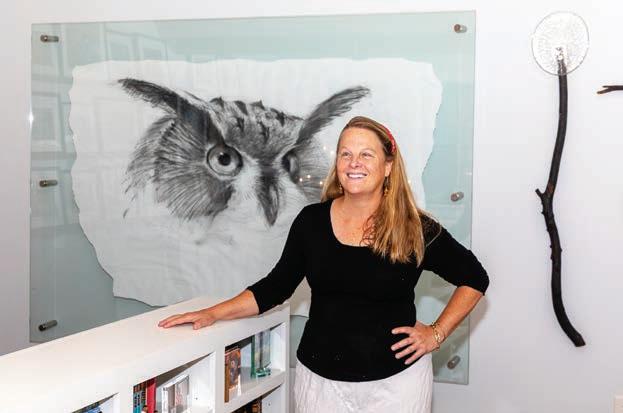


“It was basically saying, ‘What did you do as a child, and where was your joy?’ If you get back to the child in your past, you’ll find it.”
In surrendering herself to becoming lost, Benbow reliably found her way back.
Even as she kept her law practice and farmed, she explored further, attending auctioneering school and earning an associate’s degree in visual arts. “I’m a serial learner,” she playfully argues when accused of being a serial degree earner.
She insists she is a happy person, if a struggling farmer — and “even a happy lawyer.” But Benbow questions if Henry could have thrived here.
The problem was, Henry was a “bug magnet,” she jokes. Sensitive to mosquito bites, he was therefore never as keen on the country life. Plus, she would never have asked him to give up his multidimensional life.
A pensive Benbow looks outside towards the recently planted fields where flowers grew last year. Her mother often quoted a line attributed to Emerson. “The Earth laughs in flowers.”
“We had laughter in the house,” she adds wistfully.
“If you went into Mom’s house, it had a lot of energy,” she says. “Every surface was decorated with something she had made.” Each room of the farmhouse contains some of Benbow’s artwork. Her art is charged with color; exuberant, zestful.
Suddenly sheepish, she looks around her home, and adds, “This is turning into that!” After a beat, Benbow yelps.
“I’m turning into my mother!”
Behind her, the cloud cover breaks. Suddenly, sunlight drenches the fields, which seems to undulate, newly golden, where seedlings have barely emerged.
Benbow swivels, orienting her perspective to better see. Tender beginnings, which, if luck holds, will bring vigor, growth and maturity. If temperatures don’t swing madly, if there is rain and not drought, if pestilence stays at bay, there will be harvest and not heartbreak.
“Flowers are more beautiful,” she murmurs in a low register, her whole face softening into a hopeful smile.
Of course. She already sees the flowers. OH

By a shley Walshe
August is a dog’s wildest dream.
Beneath the swaying hammocks where the summer-weary rest, the sleeping pup paddles his oversized paws, snout and whiskers gently twitching.

Mute the color palette. Attune to ultrasonic frequencies. Press your nose to the warm earth and breathe.
Can you smell the amalgam of humus and bee balm?
Honeysuckle and musk? Grass clippings and sun-dried worms?
Each inhale carries a luscious stream of scents, a delectable river of possibilities. Each inhale is ecstasy.
At once, nose and paw lift as if pulled by invisible strings. A series of quick sniffs this way. A series of quick sniffs that way. A head tilt, an ear twitch, a rabbit!
Adventure calls.
Plow past the towering Joe Pye, the gleaming goldenrod, the coneflower, milkweed and asters. Faster, faster! Follow the trail, follow your instincts, follow that fluffy white tail!
Lunge left! Lunge right! Dive straight into a — cool, clear creek?
No signs of rabbits in this next dream. You plop down, let your belly press into the silty streambed, take a long, rhythmic drink. The queenking of treefrogs fills the air. A dragonfly lights on your withers.
In the third dream, you’re back with your people, belly-up in the dappled shade, nose wiggling. There’s a picnic blanket, a watermelon, a platter of cucumber sandwiches. This is a dream, right? Sure feels like it. Wonder if they’ll notice if I just sneak one bite.
Grill it. Drizzle with honey. Pickle the rinds. Make salsa, gazpacho or caprese.
There’s sorbet, smoothies, minty lemonade. Mocktails, mojitos and ice pops. Good old-fashioned juice.
Serve it sliced, scooped or cubed. Spice it up with lime, salt and chili. Or not. There’s no wrong way to eat or drink it.
Nothing says August like a bellyful of watermelon.

Believed to have originated in Africa’s Kalahari Desert as the white-pulped Kordofan melon, the modern beauty we know and love has come a long way, baby. As evidenced by its presence in tomb paintings, the striped fruit was sacred to the ancient Egyptians, cultivated as both a water and food source. Often buried alongside pharaohs, the fruit’s high water content was believed to aid souls on their arduous journey to the afterlife.
Today, popular varieties include crimson sweet, sugar baby, moon and stars, jubilee and Charleston gray.
Celebrate National Watermelon Day on Aug. 3 with a cold one.
The change always comes about mid-August, and it always catches me by surprise. I mean the day when I know that summer is fraying at the edges, that September isn’t far off and fall is just over the hill or up the valley.
— Hal Borland


The People & Businesses That Make the Triad a More Vibrant Place to Live and Work!
American Sign Shop
Community Foundation of Greater Greensboro GeekBox IT
Graphic Collective / Mindful Supply Co.
Home Helpers Home Care of Jamestown
Jobe Custom Home and Renovations
New Garden Landscaping & Nursery
Webster’s Import Service
Work-Life Solutions Concierge
SPONSORED SECTION AUGUST 2025
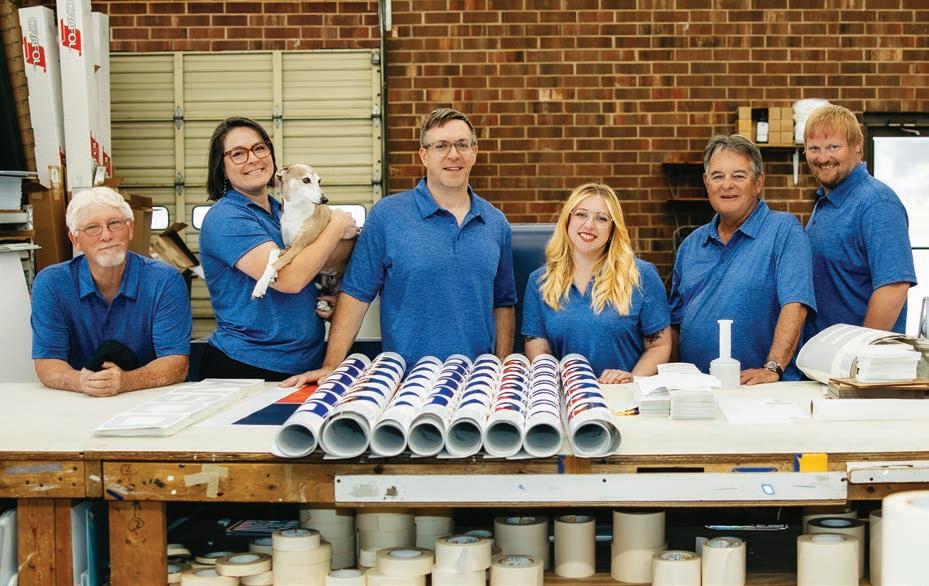
Owned by Mike Linville and Shawn Smith since 1997, American Sign Shop designs, produces and installs visually engaging brand signage and graphics for interiors, exteriors and vehicles. You might recognize some of their work at Green Valley Grill, Weatherspoon Art Museum or Cone Health, to name a few. From small, simple signs to complex fleet graphics, the team works efficiently to complete each project on time and on budget. “We realize the importance of putting people over profits.”
What makes American Sign Shop stand out? Flexibility and personal attention. “We are adept at assessing our clients’ goals, then creatively and expeditiously developing a plan of execution,” says Smith. “We foster these relationships by listening to our customers and welcoming constructive criticism that we take to heart.” That skill has enabled the business to adapt its scope of capabilities and offerings to meet community needs.
When he’s not at work, you might catch Smith filling in on drums or guitar in a local fundraising cover show. Linville,
an avid competitive fisherman, can be found helping friends up their own fishing game.
Their strong sense of community carries over into their business. “We all have each other’s backs and support each other here at work as well as in everyday life.”
At the end of the day, Linville adds, “We strive to be true to our word and fair with our pricing.”

Supporting the Black community in building wealth, expanding education and improving health are the primary goals of the Black Investments in Greensboro (BIG) Equity Fund, a permanent endowment of the Community Foundation of Greater Greensboro since 2020.
“A community grows stronger when more of its citizens can make positive contributions,” shares BIG Equity Fund steering committee member and founding donor Henry W. B. “Hank” Smith, III, MD. Retired from medicine after nearly four decades, Smith was one of the first Black cardiologists in the Triad when he joined Moses Cone in 1987. Raised in segregated Statesboro, Ga., in the 1960s, Smith graduated from Morehouse College and Harvard Medical School, and completed his internal medicine training, cardiology fellowship and faculty appointments at Emory University School of Medicine.
As a practicing physician, Smith says that “you are constantly reminded of the urgent needs within our community.” Now, he uses his experience to breathe new life and financial stability into the Black community. Comprised of Black leaders, the BIG Equity Fund aims to be the primary financial contributor in redefining how funding decisions are made in the Triad community to tackle social justice and racial equity challenges.
Thanks to the BIG Equity Fund, more Black families and organizations in our community will have what they need for a successful and prosperous future. As Smith says, “Improving education, health and socioeconomic status among the historically underserved will enhance the quality of life for all in Greensboro.”

301 N. Elm St, Ste. 100
Greensboro, NC 27401
(336) 379-9100
https://cfgg.org/big-2/


With a passion for helping others and a love for IT, John Longest and Erick Smith launched GeekBox IT in 2018, working with just two clients out of a small garage. Those two clients are still with GeekBox IT today, along with many more, thanks to the company’s active support, transparent communication and hands-on approach. Clients know that when they call the office, they will speak with one of the 16 full-time employees and receive a rapid response. In order to keep its level of service while customer demand increases, GeekBox IT plans to expand its physical footprint later this year.
With a proactive approach, GeekBox IT prevents issues before they disrupt business. The vast array of services includes everything from operating as an outsourced IT department for small, mid-sized and enterprise businesses to cybersecurity and even modern phone systems with crystal-clear call quality, mobile integration, voicemailto-email and automated call routing. At the heart of their business, John and Erick ensure that their team is trained in both IT and customer service “because people matter more than devices.”
When John and Erick aren’t focused on GeekBox IT’s client needs, they enjoy spending time with their families. Both are proud “girl dads” who love everything that comes with that, from cheering on the soccer sidelines to spending evenings at the dance studio. Balancing family life with the demands of entrepreneurship has meant “late nights, early mornings, and plenty of blood, sweat and tears,” say John and Erick. “Seeing the company grow and create jobs in our community makes it all worth it.”

1250 Revolution Mill Drive, Suite 166, Greensboro
336-790-1000
www.GeekBoxIT.com

After working in management for VF Corporation early in his career, David Grubbs felt the calling to branch out by starting new businesses, allowing him to experience the joy of working on forward-thinking projects with like-minded colleagues. Both businesses — Graphic Collective and Mindful Supply — he says, can be attributed to his love for design, fabric, graphics and marketing.
With four employees, plus artists, designers, photographers and creators who bring unique perspectives to every Graphic Collective project, Grubbs says, “It’s in the name. Collective.” But it’s more than that. Together, they often go on location for photoshoots and, when they aren’t working, they take canoe trips together down local rivers.
“I still feel that ‘anything is possible’ spirit around the city,” says Grubbs, long-time Greensboro resident and entrepreneur. Founded in 2001, Graphic Collective includes a talented group of creative aficionados who design brand identity for the likes of SouthEnd Brewing and adidas, among others. The company produces logos, websites, videos, photography, social media and everything in between. Its motto? “We’re with the Brand.” It’s sister
company, Mindful Supply, was founded in 2012, and offers shirts, hats and other mindfully made products.
When he’s not working one one of his two businesses, Grubbs can often be found with one of his “three best friends” — on the tennis court with his son, designing art with his daughter or hanging out with his wife of almost 34 years. “The rest,” he says, “is gravy.”

1175 Revolution Mill Drive, Suite 19
336-312-8891
graphiccollective.com mindfulsupply.com

Finding a reliable home care provider for a loved one with an illness or injury can be tough. Lisa Clapp Hmiel, a co-owner of Home Helpers Home Care in Jamestown, can relate. Her son Shane was paralyzed from the chest down in a racing accident in 2010, and she became his full-time caregiver. “I loved and supported him, but I wanted to be more than just his nurse. I wanted to be his mom again,” she says.
After caring for her son for three years, Lisa contacted local home care agencies for additional support, but none offered the personal care she was seeking.
Inspired by his brother’s injury and his mother’s plight, Lisa’s younger son, Tyler, made it his mission to create a home health agency where caregivers treat their patients like family.
Tyler launched Home Helpers of Jamestown in 2013, running it as a true family business alongside Lisa, who came armed with over 35 years of industry experience, and his wife, Kayla. The company now has 63 caregivers and each one is thoughtfully selected, ensuring that patients and their families receive the highest level of compassionate, individualized care.
“We match staff and clients intentionally to foster trust and build long-term relationships,” says Tyler. After all, the Hmiels aren’t only in the home care business, but in the relationship business, making the lives of their clients and their families easier. “This is our calling.”




Destined to build beautiful homes from an early age, Jobe Custom Homes and Renovations owner and president Todd Powley has always loved carpentry and construction. As a high school senior in Charlottesville, Va., Powley won the Virginia State Vocational Industrial Clubs of America (VICA) Club Carpentry Competition. “I lost out to a girl in the national competition,” Powley says. “I’m old enough now to admit it!”
Working for the company for more than 30 years, Powley purchased the business in 2022 when founder Gary Jobe retired. Focusing on relationships with clients, superintendents, designers, vendor partners and subcontractors, the company has been committed to quality, expert craftsmanship, and collaboration since 1972, when Jobe launched the Triad-based company. Today, Powley’s team consists of nine dedicated employees and several longtime subcontractors and vendor partners who, he says, contribute to the company’s success.
From sleek and modern estates to cozy cottages, one of Jobe Custom Homes’ greatest strengths is its ability to seamlessly work through the many details of construction, bringing each client’s vision to life. “We do not build spec homes,” says Powley. “Our superintendents work with each client and their design team from the start — from the estimating and contract stage, through the entire construction phase. Each project is truly a team effort.”
When not wearing his hardhat, Powley enjoys camping, fishing and getting away from it all at the Outer Banks with his wife of 37 years, Marsha, their two grown children and their spouses, and his precious new granddaughter. 409-A Parkway Street, Greensboro 336-272-2772 jobecustomhomes.com
Driving down any neighborhood street in the Triad, you’ll likely encounter a sign posted in front of a beautiful yard, saying it was landscaped by New Garden Landscaping & Nursery Inc. Since 1977, the premier residential landscaping and horticultural company has served the area with its skilled and knowledgeable landscape designers, landscape construction and landscape maintenance teams.
Half of New Garden Landscaping & Nursery’s business consists of landscape maintenance: mowing, pruning, edging and blowing of hard surfaces. Landscape design and construction make up the other half, including the installation of patios, outdoor kitchens, retaining walls, plant material, irrigation and landscape lighting.
Exceptional work and professionalism set New Garden Landscaping & Nursery apart. With the 2024 purchase of Landscape Irrigation Systems (LIS) and Nature’s Select, its offerings have expanded to include irrigation service, landscape lighting installation and service, and biologically enhanced lawn and shrub care. New Garden Landscaping & Nursery was purchased by Matt Hunter in 2020. Growing up in Toledo, Ohio, Matt spent most of his teen years working on a friend’s family farm, where he assisted
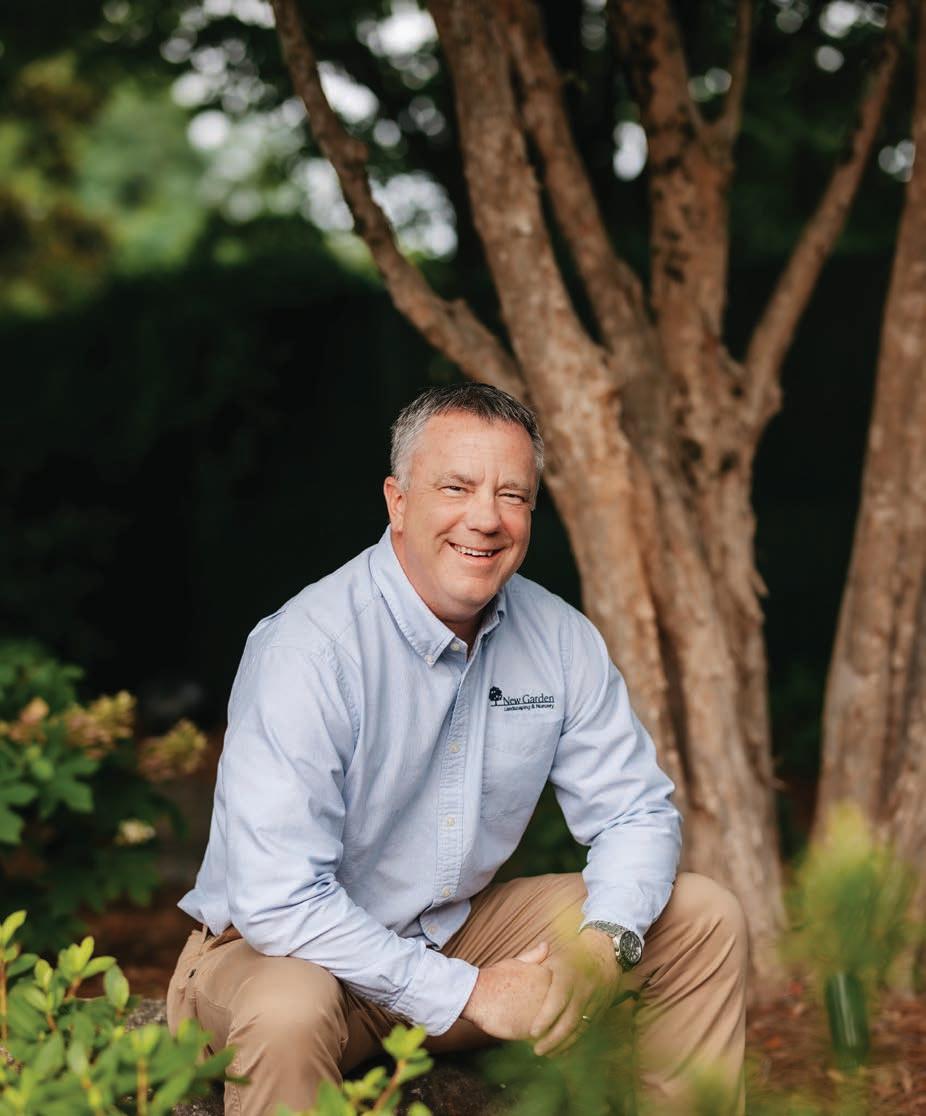
with the growing of annuals, picking strawberries and apples, and selling Christmas trees, plus mowing lawns in his neighborhood. A proud North Carolina Licensed Landscape Contractor and Irrigation Contractor, Matt moved to the Triad 35 years ago. He’s married to his high school sweetheart, Christie, and they have two daughters, Katelyn and Alexis.
Besides his family, Matt is most proud of creating opportunities for people to build careers in the landscaping industry. Landscaping, he believes, improves the physical environment while creating space for people to relax, spend time with loved ones and foster lifelong memories.




For nearly 40 years, Webster’s Import Service has proudly served Triad customers with high-quality auto repair and maintenance. Founded by the Webster family, the company was purchased by James R. Cornell III in 2023. A High Point native and ASE (Automotive Service Excellence) certified technician, James has more than 30 years of mechanical experience and continues training and acquiring certifications, including Complete Toyota Diagnosis 2017, Toyota/Lexus Engine Performance and Toyota Hybrid Drive.
Webster’s Import Service communicates openly during all phases of the auto repair or service, establishing a high level of trust with customers. Safety and convenience are paramount to the company’s 12 employees, focusing on each customer making it seamlessly to their destination. Plus, the courtesy shuttle and service warranties provided, features not found at all auto service centers, are appreciated by customers.
“Webster’s Import Service,” says James, “could not provide the excellent service to our customers without our professional, hardworking team, from the front-end management to the automotive technicians and shuttle drivers.”
Handling all auto repairs and maintenance from simple oil changes to complex engine and transmission repairs, the team at Webster’s Import Service works on everything from brakes to radiators. With a focus on expansion, Webster Import Services is always looking to hire additional qualified, professional automotive technicians.
“Webster’s Import Service is still a family business,” notes James. After all, his mother works part-time as HR and office manager.
When James isn’t under the hood of a car, he enjoys being outside in nature, riding motorcycles and getting together with family and friends for backyard cookouts.

306 Grumman Road, Greensboro 336-393-0023
www.webstersimportservice.com


Launched in Greensboro in 2018 by owner Donielle Jopko to solve challenges that organizations face in today’s evolving business environment, Work Life Solutions Concierge (WLS) overwhelmingly delivers successful outcomes for their clients by bridging the gap that companies need in this challenging environment by saving them time and money.
With clients ranging from solo entrepreneurs to Fortune 500 companies and a focus on companies moving into North Carolina, the WLS team helps to remove each client’s barriers for growth by developing and guiding people-centered projects, along with providing ongoing strategic support. “Our ability to customize solutions while maintaining consistent quality and service allows us to meet the diverse needs of any client,” says Jopko, “regardless of industry or scale.”
People are at the heart of all WLS projects. WLS team members partner with business leaders to offer solutions in two main areas: Fractional Project Management, from training sessions to company culture development, and Relocation Management, with packing, unpacking, decluttering and interior design.
“We start by listening, then deliver thoughtful, customized recommendations designed for success,” explains Jopko. With a mission to become the only service provider WLS’s clients will ever need, WLS is expanding beyond North Carolina into the Southern market. As this mission takes shape, the WLS team is also growing to keep up with client demand.
What does a busy solutions expert do in her free time? You may find Jopko at one of her teenage son’s lacrosse or soccer games, boating in a nearby lake, discovering a secret waterfall, or cooking at home with friends.

1852 Banking Street, #9234, Greensboro
336-561-1152
www.wlsconcierge.com
Before attending any event, it’s best to check times, costs, status and location. Although we conscientiously use the most accurate and up-to-date information, the world is subject to change and errors occur!
August 1–31
MAKING CONNECTIONS . This installation of works from the Weatherspoon’s attic showcases the gallery as an academic museum with abiding connections to its campus, Greensboro and broader communities. Free. Weatherspoon Art Museum, 500 Tate St., Greensboro. Info: weatherspoonart.org/exhibitions/ current-exhibitions.
CONSTANT/CHANGE. Explore the works of eight outstanding emerging North Carolina artists in this juried exhibition. Free. GreenHill Center for NC Art, 200 N. Davie St., Greensboro. Info: greenhillnc. org/exhibitions.
PATTERN RECOGNITION. Explore the power of pattern in this exhibit featuring works from the Weatherspoon collection. Free. Weatherspoon Art Museum, 500 Tate St., Greensboro. Info: weatherspoonart. org/exhibitions/current-exhibitions.
ARTISTS AT EDGEWOOD. 10 a.m.–5 p.m. Meet some of the 30 artists-inresidence at Elliott Daingerfield’s restored historic cottage in Blowing Rock. Featured artists change weekly. Free. Main Street and Ginny Stevens Lane, Blowing Rock. Info: artistsatedgewood.org.
August 1–23
THE DARK SHOW. Explore the interplay of light and shadow through an immersive, glowing experience featuring luminous, light-emitting works in glass, ceramics, and other mediums. Free. Starworks, 100 Russell Drive, Star. Info: starworksnc.org.
AUGUST 1–9
RUGLIFE . Explore the work of contemporary artists who use rugs as a medium
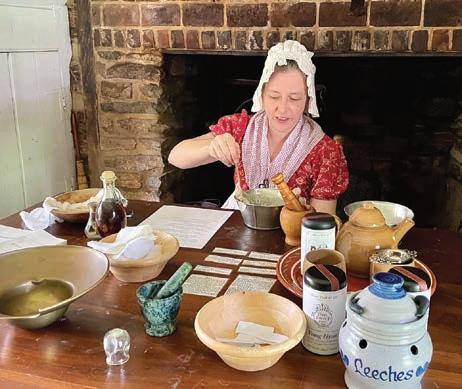
August 9, 10 a.m. - 4:30 p.m.
Hoggat House at High Point Museum
to address a range of cultural topics, from housing and the environment to technology and global politics. Free. Weatherspoon Art Museum, 500 Tate St., Greensboro. Info: weatherspoonart.org/ exhibitions/current-exhibitions.
GADISSE LEE . Explore the vibrant, saturated photography of this Ethiopian born and raised UNCG graduate, whose work celebrates the Black female figure; hear from the artist at 6 p.m., Wednesday, July 23. Free. GreenHill Center for NC Art, 200 N. Davie St., Greensboro. Info: greenhillnc.org/exhibitions.
August 1
FIRST FRIDAY. 6–9 p.m. Head downtown for a night of live music and happenings stretching all the way from LeBauer Park and the Greensboro Cultural Center to the South End. Free. Downtown Greensboro. Info: downtowngreensboro.org/first-friday.
FIRST FRIDAY STORYTIME. 10–10:30
a.m. Bring your young children outside to enjoy engaging books, playful movement and cheerful songs with a member of the Youth Librarians team from Greensboro Public Library. The first 15 families can snag a free book courtesy of Ready for School, Ready for Life and The Basics Guilford. Free. Woven Works Park, 401 Cumberland St., Greensboro. Info: downtowngreenway.org/events.
LOUIS CK. 7:30 p.m. The six-time Emmy and three-time Grammy winner takes the stage for a night of comedy. Tickets: $56.90+. Steven Tanger Center, 300 N. Elm St., Greensboro. Info: tangercenter. com/events.
August 2
OPEN ART REVIEW. 11 a.m.–2 p.m. Using the Pecha Kucha format, artists will each exhibit 10 images of their work in a 3 ½ minute presentation. Free. GreenHill Center for NC Art, 200 N. Davie St., Greensboro. Info: greenhillnc.org/events.
JEEZY. 8 p.m. The hip hop star celebrates the 20th anniversary of his groundbreaking Let’s Get It: Thug Motivation album. Tickets: $123.65+. Steven Tanger Center, 300 N. Elm St., Greensboro. Info: tangercenter.com/events.
EMERGING ARTISTS SERIES. 8 p.m. Mississippi folk singer-songwriter Pony Bradshaw is joined by emerging local artist Jesse Fox, known for his melodic soulfulness and lyrical mastery. Tickets: $28+. Flat Iron, 221 Summit Ave., Greensboro. Info: flatirongso. com/events.
JAMIE TROUT. 6:30–8:30 p.m. Enjoy tunes from the Asheboro chanteuse while you sip and savor snacks. Free. Starworks Cafe & Tap Room, 100 Russell Drive, Star. Info: starworksnc. org/starworks-events.
BEST OF 48 HOUR FILM PROJECT.
7 p.m. Watch the very best of short films created by locals in under 48 hours. Tickets: $15. Carolina Theatre, 310 S. Greene St., Greensboro. Info: carolinatheatre.com/events.
August 3 & 10
KARAOKE & LINE DANCING.
4–7 p.m.
Two of your fav activities merge for one evening of fun with DJ Energizer. Free. Center City Park, 200 N. Elm St., Greensboro. Info: greensborodowntownparks.org/calendar.
August 4–14
SUMMER FILM FEST. 7 p.m. Munch on movie theater popcorn while catching the season’s popular classics, from Vertigo to Frenzy, from The Wiz to La La Land . Tickets: $8+. Carolina Theatre, 310 S. Greene St., Greensboro. Info: carolinatheatre.com/events.
August 5
COLLECTIVE SOUL & LIVE. 6 p.m. Two iconic ’90s bands perform one memorable summer show. Tickets: $53.30+. White Oak Amphitheatre, 1403 Berwick St., Greensboro. Info: gsocomplex.com/events.
FAMILY MOVIE NIGHT. 7:30–10 p.m. In honor of National Night Out, enjoy an outdoor screening of Inside Out . Free. Historical Park at High Point Museum, 1859 E. Lexington Ave., High Point. Info: highpointmuseum.org.
August 6
READING THE WORLD. 7–8 p.m.
Discover and discuss contemporary authors’ works in translation, such as this month’s pick — Korean blockbuster Marigold Mind Laundry by Jungeun Yun. Free. Online. Info: scuppernongbooks.com/events.

August 1 - 23
The Dark Show: Starworks
CAROLINA KIDS CLUB. 9 a.m. After visiting the musical petting zoo and taking in a Mad Science show, keep your kiddos cool while watching Toy Story 4 and noshing on complimentary kids’ snack packs. Tickets: $5+. Carolina Theatre, 310 S. Greene St., Greensboro. Info: carolinatheatre.com/events.
August 7–10
SHAKESPEARE IN THE PARK. “One touch of nature makes the whole world kin,” according to the famous bard. Catch one of a series of plays inspired by William Shakespeare and performed outdoors in a Greensboro park. Info: greensboro-nc.gov/departments/ creative-greensboro.
August 9
TEA & POTTERY. 10 a.m.–5 p.m. Celebrate the 10th anniversary of Tea
with Seagrove Potters by dropping by venues to sample Carriage House Tea, Table Farmhouse Bakery and Seagrove Cafe pastries, plus homemade treats from Blue Hen, Dean & Martin, Eck McCanless, From the Ground Up, Red Hare and Thomas potteries. Plus, enjoy door prizes and gifts with any purchase for early shoppers. Free. Seagrove. Info: teawithseagrovepotters.com.
LITTLE LEAGUE LEGENDS. 2–3:30 p.m. Enjoy a conversation with alumni of the undefeated 1965–1968 East Greensboro Little League team, the Bluford Blues, organized with Greensboro Parks & Recreation. Free. Greensboro History Museum, 130 Summit Ave., Greensboro. Info: greensborohistory.org/events.
19TH-CENTURY MEDICINE. 10 a.m.–4:30 p.m. Head to the Hoggatt House, the oldest building in High Point, and learn about the four humors of the body, plus homemade remedies and popular medicines once used for typical ailments. Free. Hoggat House at High Point Museum, 1859 E. Lexington Ave., High Point. Info: highpointmuseum.org.
ULTIMATE COMIC CHALLENGE. 8 p.m. Catch the finals as the remaining comics compete for the title. Tickets: $22.78. The Idiot Box, 503 N. Greene St., Greensboro. Info: idiotboxers.com.
JON REEP. 7 p.m. The 2007 winner of Last Comic Standing is still bringing the laughs to the stage. Tickets: $34.96+. High Point Theatre, 220 E. Commerce Ave., High Point. Info: highpointtheatre. com/events.
MARIACHI VARGAS DE TECALITLÁN. 8 p.m. Julio Preciado joins the ensemble for an evening of mariachi magic. Tickets: $92.35+. Steven Tanger Center, 300 N. Elm St., Greensboro. Info: tangercenter.com/events.
ROD BRADY & RUSTED LUCK. 6:30–8:30 p.m. Sip, snack and and tap your feet to the tunes of this Americana-rock group from Liberty. Free. Starworks Cafe & Tap Room, 100 Russell Drive, Star. Info: starworksnc. org/starworks-events.
August 10 & 24
MUSEP. 6 p.m. Music for a Sunday
Evening in the Park features a lineup of free concerts including Soultrii, The Phoebes and Nu-Blu at a variety of city parks, where you can also find food trucks or concessions on site. Free, donations encouraged. Info: greensboro-nc. gov/departments/creative-greensboro.
August 13
A DUO OF DUOS. 7:30 p.m. A Tale of Two is joined by A Different Thread for an evening that blends Americana and transcontinental folk. Tickets: $13.96+. Flat Iron, 221 Summit Ave., Greensboro. Info: flatirongso.com/events.
August 16
AVANT-GARDE GALA. 5–10 p.m. Design your own Avant-Garde garb to wear as you sip, snack, enjoy artistic performances and live music, and honor outstanding community arts and culture leaders at TAB Arts Center’s fundraising gala. Tickets: $125. The Terrace at Greensboro Coliseum, 1927 W. Gate City Blvd., Greensboro. Info: tabartscenter.org/calendar.
JIM LAUDERDALE. 6 p.m. The singersongwriter whose talents span several genres takes the stage for an early show. Tickets: $28+. Flat Iron, 221 Summit Ave., Greensboro. Info: flatirongso.com/ events.
SONGBIRD EXPERIENCE. 8 p.m. SongBird Raven returns for her annual show, this time with Tish SongBird, performing a night of tunes that encompass all genres, allowing her unique voice to captivate, inspire and take listeners on a musical flight. Tickets: $20+. In the Crown at the Carolina Theatre, 310 S. Greene St., Greensboro. Info: carolinatheatre.com/ events.
August 17
CHROMATICA. 3–6 p.m. Chromatica Sings N’ Things invites the community to blend karaoke, singing, spoken word, line dancing and more movement for a shared moment of joy. Free. Center City Park, 200 N. Elm St., Greensboro. Info: greensborodowntownparks.org/calendar.


August 23
ELTON JOHN TRIBUTE. 8 p.m. You can tell everybody that this is “Your Song” when Rus Anderson steps into the role of Elton John at The Rocket Man Show. Tickets: $39.50+. Steven Tanger Center, 300 N. Elm St., Greensboro. Info: tangercenter.com/events.
FAMILY FUN DAY. 10 a.m.–2 p.m. Enjoy a picnic in the park, historic games, sidewalk chalk and toys, while cooling off with delicious popsicles and treats. Free. Historical Park at High Point Museum, 1859 E. Lexington Ave., High Point. Info: highpointmuseum.org.
BEGINNER WELDING. 9:30 a.m.–3:30 p.m. Learn the basics of welding in this one-day workshop that offers hands-on experience. Registration: $250. Starworks, 100 Russell Drive, Star. Info: starworksnc.org/metal-classes.
COLIN CUTLER. 6:30–8:30 p.m. Sip, snack and sway while Greensboro’s own provides a live soundtrack to your chill


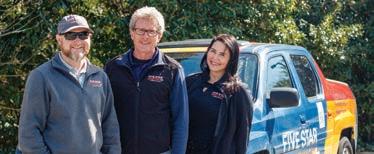
























































evening. Free. Starworks Cafe & Tap Room, 100 Russell Drive, Star. Info: starworksnc.org/starworks-events.
August 23
OZ FEST. Noon–4 p.m. Celebrate the 30th anniversary of Community Theatre of Greensboro’s Wizard of Oz productions with food trucks, Oz-some crafts and vendors, face painting, bouncy houses, music, games and Wicked karaoke. Free. Downtown Greensboro. Info: theacgg.org/arts-organizations/ organization-highlight-oz-fest.
August 24 & 31
MUSIC IN THE PARK. 4–7 p.m. Dance the evening away amongst friends and green park scenery. Free. Center City Park, 200 N. Elm St., Greensboro. Info: greensborodowntownparks.org/calendar.
August 24
BRIT FLOYD. 8 p.m. Enjoy a night of Pink Floyd’s music, celebrating 50 years of the iconic album, Wish You Were Here, from the renowned tribute band,
complete with stunning soundscapes and visuals. Tickets: $34+. Steven Tanger Center, 300 N. Elm St., Greensboro. Info: tangercenter.com/events.
August 25
THE MOST INFLUENTIAL FASHION DESIGNER YOU’VE NEVER HEARD OF. 6–7:30 p.m. Discover the history of the woman who changed American fashion forever as author Elizabeth Evitts Dickinson discusses her book, Claire McCardell: The Designer Who Set Women Free. Free. Greensboro History Museum, 130 Summit Ave., Greensboro. Info: greensborohistory.org/events.
ROMANCE BOOK CLUB. 7 p.m. Romance is not dead — it’s alive and well at Scuppernong Books’ monthly online book club, where this month’s selection is Last Call at the Local by Sarah Grunder Ruiz. Free. Info: scuppernongbooks.com/ events/calendar.
August 27
CAMP ART SHOW. 4–7 p.m. Peruse the works of budding artists who have been
honing their skills at GreenHill’s summer camps; selected works will be available for $10 purchase. Free. GreenHill Center for NC Art, 200 N. Davie St., Greensboro. Info: greenhillnc.org/events.
JAZZ NIGHT. 6:30 p.m. Sip brews and munch on tasty eats while tapping your feet to Soul Noises. Free. Starworks Cafe & Tap Room, 100 Russell Drive, Star. Info: starworksnc.org/starworks-events.
August 29–31
CENTRAL CAROLINA FAIR. Experience thrilling rides, exciting games, and mouth-watering fair food while making memories. Greensboro Coliseum parking lot, 1921 W. Gate City Blvd., Greensboro. Info: gsocomplex.com/events.
August 29
MUSCADINE BLOODLINE. 8 p.m. Enjoy an evening of lively anthems as well as soul-baring ballads from this modern country duo. Tickets: $44.55. Piedmont Hall, 1921 W. Gate City Blvd., Greensboro. Info: gsocomplex.com/ events.



LOCAL FOLK GSO. 7–9:30 p.m. The N.C. Folk Fest’s last pop-up concert before the main event in September shines a light on local talents Victoria Victoria and katie.blvd. Free. Oden Brewing, 802 W. Gate City Bvd., Greensboro. Info:. ncfolkfestival.com/events.
ATUL PUROHIT. 8:30 p.m. The Gujarati folk singer from India known for his Garbas performs. Tickets: $32.10+. Special Events Center at the Greensboro Coliseum, 1921 W. Gate City Blvd., Greensboro. Info: gsocomplex.com/events.
August 30
DISNEY’S DESCENDANTS & ZOMBIES. 7 p.m. In the Worlds Collide Tour, stars from both hit Disney franchises perform live. Tickets: $61.45+. First Horizon Coliseum, 1921 W. Gate City Blvd., Greensboro. Info: gsocomplex. com/events.
TRACY BATES. 6:30–8:30 p.m. Put on your dancin’ boots for an evening of country crooning while you sip, snack and groove. Free. Starworks Cafe & Tap
Room, 100 Russell Drive, Star. Info: starworksnc.org/starworks-events.
WEDNESDAYS
LIVE MUSIC & PAINTING. 6–9 p.m. Evan Olson and Jessica Mashburn of AM rOdeO play covers and original music while artist-in-residence Chip Holton paints. Free. Lucky 32. 1421 Westover Terrace, Greensboro. Info: lucky32.com.
FAMILY NIGHT. 5–7 p.m. Enjoy an artdriven evening with family and friends in the studios. Free. ArtQuest at GreenHill Center for NC Art, 200 N. Davie St., Greensboro. Info: greenhillnc.org/events.
MUSIC IN THE PARK. 6–8 p.m. Sip and snack at LeBauer Park while grooving to local and regional artists. Free. Lawn Service, 208 N. Davie St, Greensboro. Info: greensborodowntownparks.org/ calendar.
THURSDAYS
ART IN THE PARK. 11 a.m.–noon.

GreenHill artist-instructors will lead kids ages 2–12 in creative outdoor activities. Free. Lincoln Financial Children’s Garden at LeBauer Park, 201 N. Davie St., Greensboro. Info: greenhillnc.org/ events.
JAZZ AT THE O.HENRY. 6–9 p.m. Sip vintage craft cocktails and snack on tapas while the O.Henry Trio performs with a different jazz vocalist each week. Free. O.Henry Hotel Social Lobby, 624 Green Valley Road, Greensboro. Info: ohenryhotel.com/o-henry-jazz.
THURSDAYS & SATURDAYS
KARAOKE & COCKTAILS. 8 p.m. until midnight, Thursdays; 9 p.m. until midnight, Saturdays. Courtney Chandler hosts a night of sipping and singing. Free. 19 & Timber Bar at Grandover Resort & Spa, 1000 Club Road, Greensboro. Info: grandoverresort.com.
FRIDAYS
MINDFULNESS MEDITATION.
Noon–12:30 p.m. This free introductory class offers a guided meditation for reducing stress in both the mind and body. Free, registration required; adults only. Triad Pelvic Health, 5574 Garden Village Way, Greensboro. Info: triadpelvichealth. com/classes.
FRIDAYS & SATURDAYS
LIVE MUSIC. 7–10 p.m. Enjoy drinks in the 1808 Lobby Bar while soaking up live music provided by local artists. Free. Grandover Resort & Spa, 1000 Club Road, Greensboro. Info: grandoverresort.com.
SATURDAYS
HISTORIC WALKING TOURS. 1 & 5 p.m. Take a guided walking tour through the history of downtown Greensboro at 1 p.m. or, if you’re into true crime, stroll through The Gate City’s darker side, covering 1953–1997, at 5 p.m. Tickets: $14. The Bodega, 313 S. Greene St., Greensboro. Info: trianglewalkingtours. com/book-online.
BLACKSMITH DEMONSTRATION. 10 a.m.–4:30 p.m. Watch the sparks fly and red-hot iron turn into farm implements as the past is recreated under the able hands of a costumed blacksmith. Free. Historical Park at High Point Museum, 1859 E. Lexington Ave., High Point. Info: highpointmuseum.org. OH
PINK GLADIOLUS AND PEARS • 40” X 40 ” • ORIGINAL OIL
SAVE THE DATE: SEPTEMBER 21ST 1:00-5:00PM ART IN THE GARDEN 1206 W CORNWALLIS DR GSO
Hundreds of original oil paintings by CPLogan, students and more for sale at studio prices! www. CPLogan.com



Guilford Green Foundation & LGBTQ Centers’s Annual Gala Starmount Forest Country Club
March 22, 2025
Photographs by VanderVeen Photographers

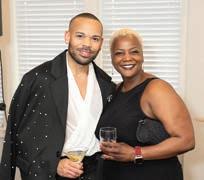

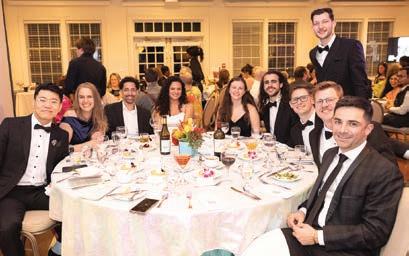



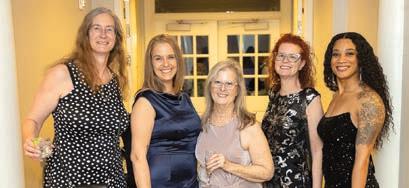

Greensboro Country Club
March 27, 2025

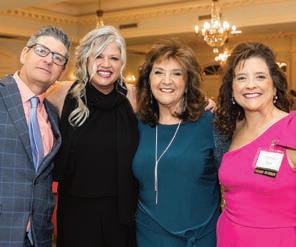


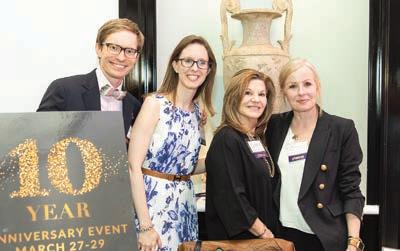


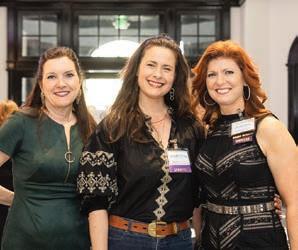
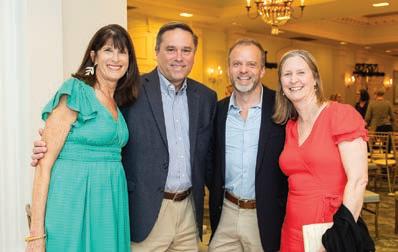
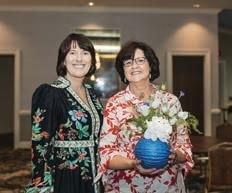
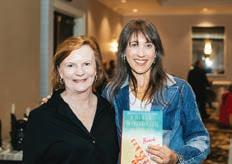
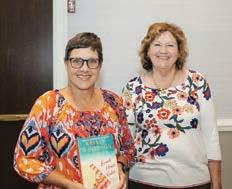
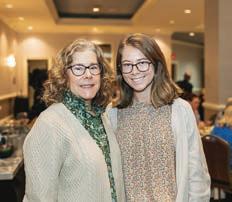
O.Henry Magazine Author Series
Grandover Resort & Spa
May 27, 2025
Photographs by Betsy Blake
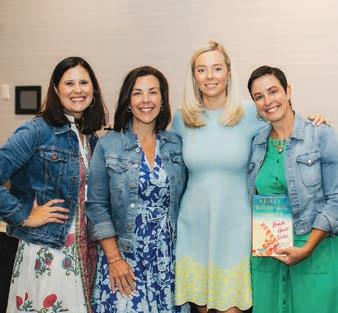


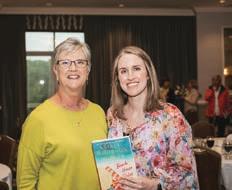

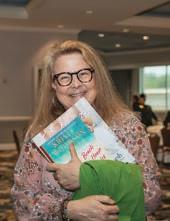

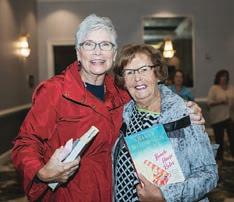
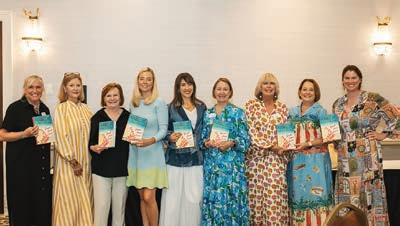
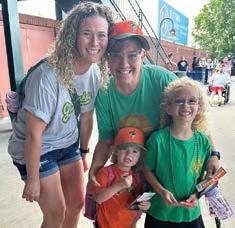



First National Bank Field
May 1, 2025
Photographs by Cecelia Thompson


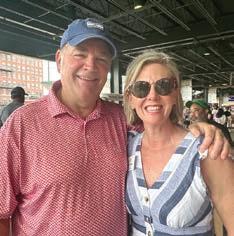


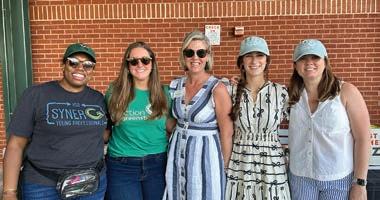

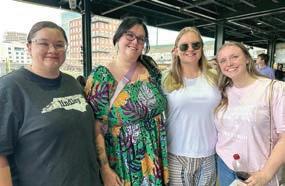
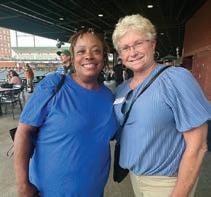

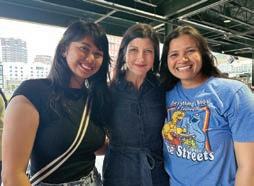
Please disembark safely and enjoy your day
By Cassie Bustamante
I stand, feet firmly planted on the ground, next to my two kids, a large, looping rollercoaster looming above our heads. Sawyer, 9, has zero interest in being thrust upside-down — no thank you, sir! Emmy, 8 and not yet tall enough to board, watches wistfully as my husband, Chris, hands me his baseball cap and makes his way alone to the line for the 97-degree drop of Fahrenheit, one of Hersheypark’s wildest rides
Like Emmy, I was the second of two children and much more the thrill seeker than my older brother, Dana. He was no scaredycat, but he wasn’t leaping in blindly either. Meanwhile, I boarded the jankiest of old wooden coasters, not an ounce of concern for my safety. If others had ridden before — and walked away OK — that was enough for me. As my height inched slowly up, so did the rides. No more wimpy-hilled kid coasters for me, I was ready to be thrown upside-down-and-around at great speeds and even greater heights.
Thankfully, the summer I turned 11, my parents planned a vacation that would scratch everyone’s itch, a road trip from our home in Massachusetts to Virginia. My father sat on our familyroom sofa, knees splayed and a road atlas opened on the coffee table in front of him, sketching out our route on a yellow legal pad. This was the 1980s after all, before the days of Waze.
We took a rolling scenic route through the Blue Ridge Mountains on the way down. Dad’s always been interested in nature photography. In fact, a photo he shot graces the cover of the fall 2009 Chesapeake Magazine. And Mom? Colonial Williamsburg was top of her list. For Dana and me, 12 and 10 at the time, there was bicycling along the Virginia Beach boardwalk and — my thrill-loving heart pitter-pattered at the very thought of it — Busch Gardens, an amusement park where roller coasters, whirling, spinning rides and a white-water-rafting adventure awaited.
After waiting in line, Dad and I buckled into the Kelly-green


seats of the school-bus-yellow Loch Ness Monster ride, which has been thrilling passengers for just as long as I’ve been taking my parents and brother on a wild ride, since 1978. I can’t even tell you what happened, it went so fast. All I know is, as soon as my feet hit the ground, I was shouting, “Again!” Dana joined me for my second ride.
While the Loch Ness was a hard pass for Mom, she put on a brave face for The Big Bad Wolf, a suspension-seat rollercoaster with zero loops. I opted for the very front car and Dana took the seat next to me. Mom sat behind us with another woman, probably mother to some other pair of kiddos. After the Nessie, the Wolf seemed rather tame. However, Mom howled the entire time, screaming as if an actual wolf was chasing her over the entire German-inspired village below. Dana and I were mortified.
But now, standing at Hersheypark with my own two kids, I understand. Something in me changed when I had kids and, at the very thought of a wild rollercoaster ride, my knees quake.
Windswept, Chris returns to where Sawyer, Emmy and I stand. I hand him back his hat to cover the mess his hair has become. “That,” he says with a dramatic pause, “was incredible!” His eyebrows inch up at me. “You want me to stay with the kids so you can have a turn?”
I look him in the eye as a spark of adventure passes briefly through me. I answer confidently, “Not in a million years.” OH
National Roller Coaster Day, August 16, falls on a Saturday this year. Celebrate with a wild ride of your own — or not.



